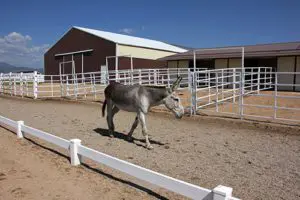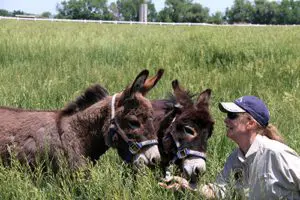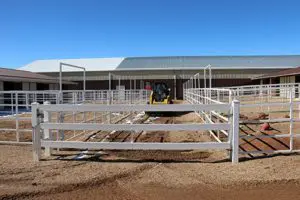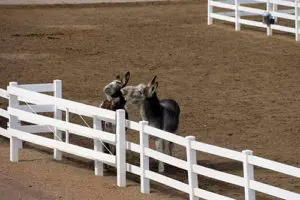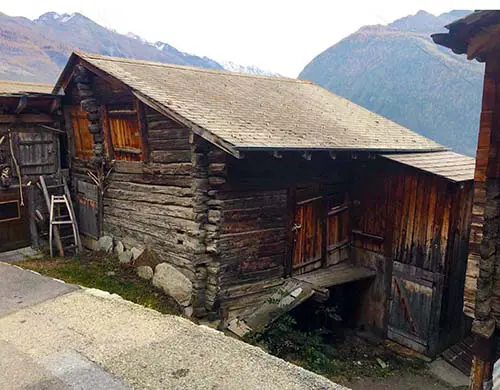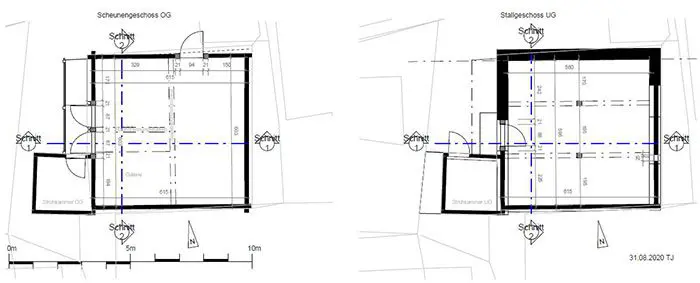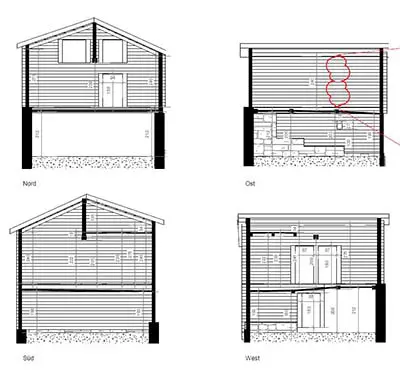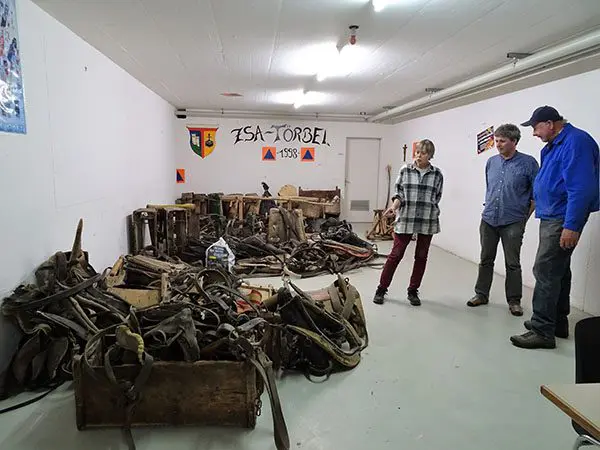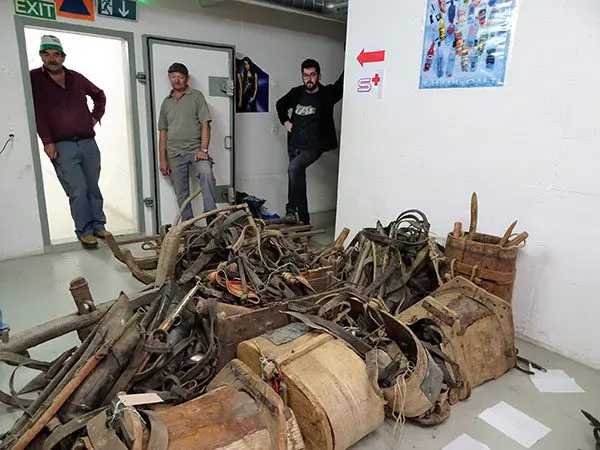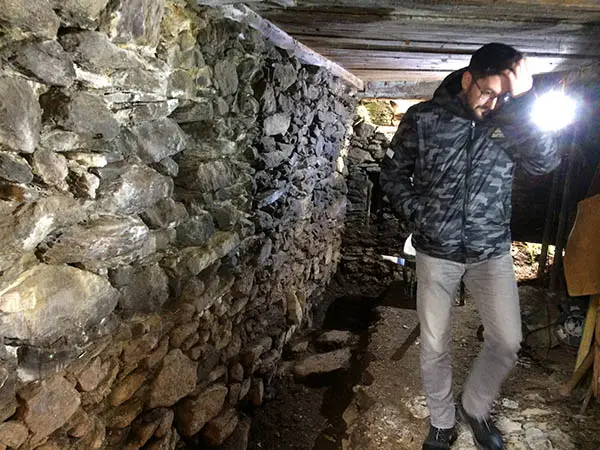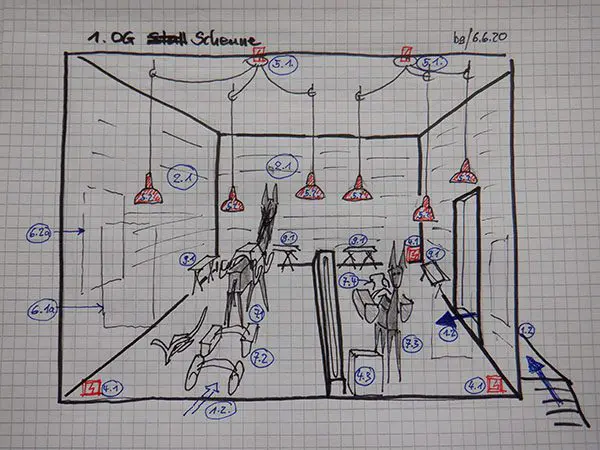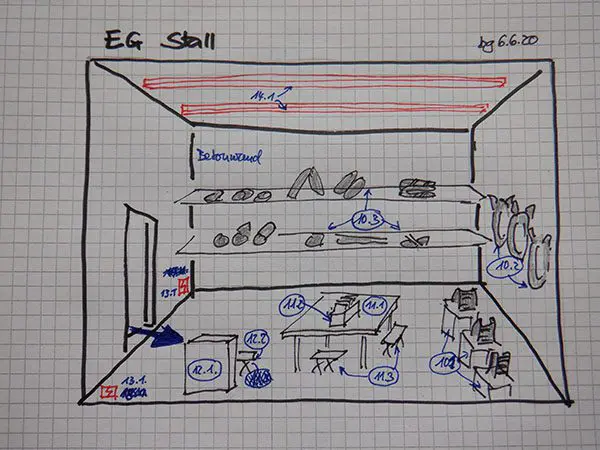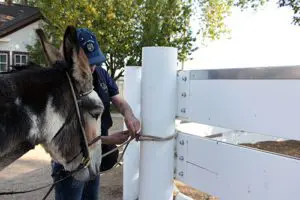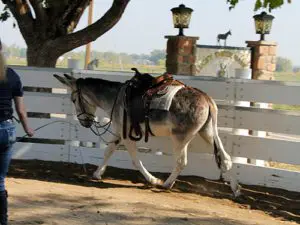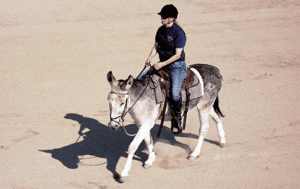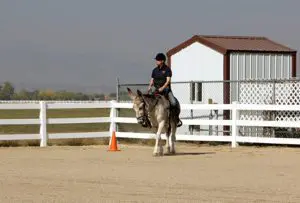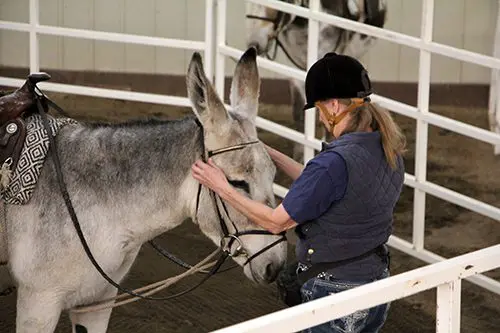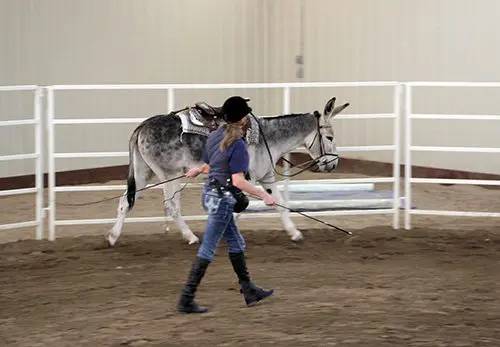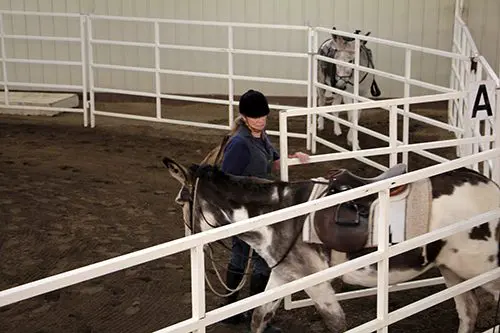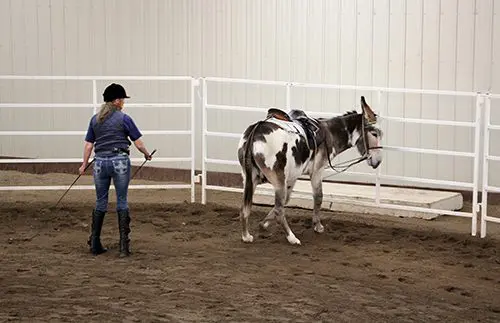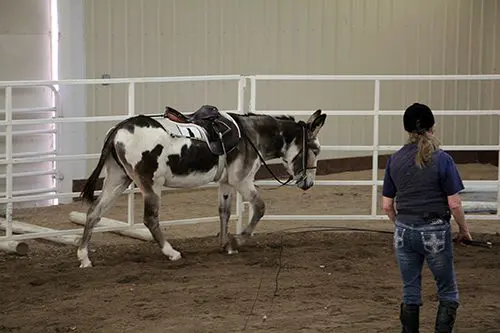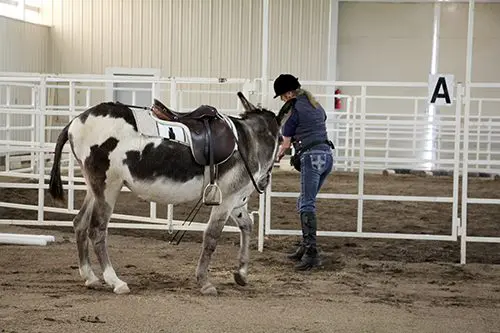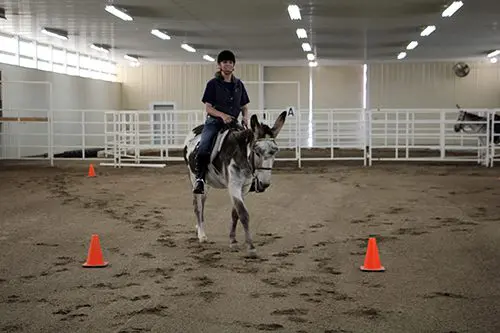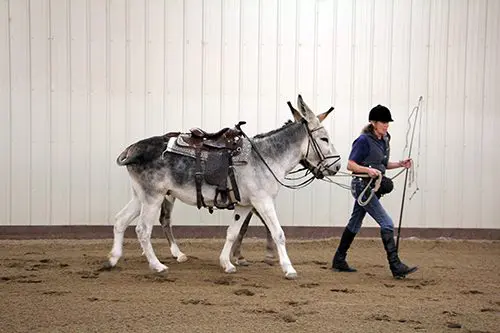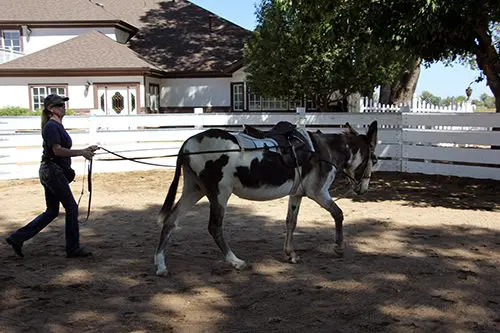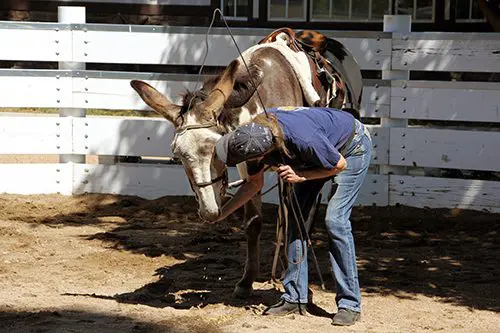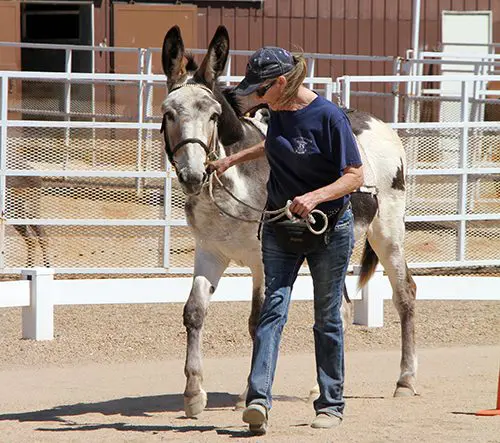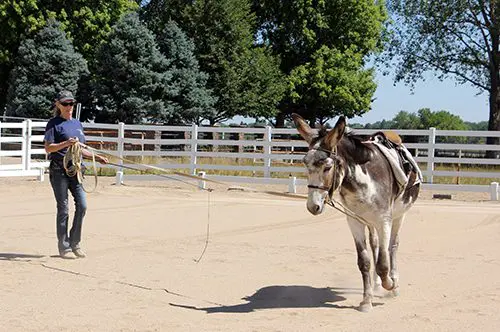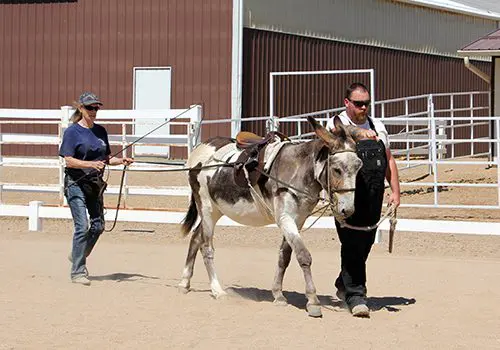
LTR Blog
Posts to share on the LTR blog


MULE CROSSING: The Responsible Use of Restraints in Training
By Meredith Hodges
There is a lot of discussion about training mules versus training horses. There are some who say that training mules is harder than training horses, and others who say just the opposite. It has been my experience that it isn’t really that one animal is more difficult to train than the other. They each have their redeeming qualities and individual limitations. The people who are dealing with them also have their own redeeming and limiting factors. For instance, if you are leading a horse, and he does not want to follow you, because he hasn’t the strength in his head and neck as a mule, or donkey, does, he can be more easily bullied into compliance with a quick jerk on the lead rope.
 On the other hand, if you are leading a mule, or a donkey, they can easily jerk the rope right out of your hands, or jerk you right off your feet, because of the incredible strength they have in their head and neck. When you teach a mule or donkey something one day, he will ponder what he has been taught during the days between lessons. Regardless of how many days or weeks pass, he will comply more easily during the next lesson because he never forgets what has been taught. A horse will tend to forget and will need to be reminded where mules and donkeys will not necessarily need those constant reminders.
On the other hand, if you are leading a mule, or a donkey, they can easily jerk the rope right out of your hands, or jerk you right off your feet, because of the incredible strength they have in their head and neck. When you teach a mule or donkey something one day, he will ponder what he has been taught during the days between lessons. Regardless of how many days or weeks pass, he will comply more easily during the next lesson because he never forgets what has been taught. A horse will tend to forget and will need to be reminded where mules and donkeys will not necessarily need those constant reminders.
It makes sense that the handler needs to adjust his training program such that the horse has many frequent and consistent lessons to refresh his memory. Longears will only need lessons as frequently and consistently as it takes to maintain good postural conditioning. When applying lessons more frequently, the handler has the ability to make subtle adjustments to get the best from the horse. If he wants a Longears to respond properly, it is critical that he teaches the mule or donkey correctly the first time. They will learn EXACTLY what the handler teaches them the first time and will continue to repeat it. The option of changing your approach during the training sequence is limited Longears. What this all amounts to is that one is really not more easily trained than the other. Rather, it is the experience and knowledge of the handler or trainer, that makes the difference with both Longears and horses.
Mules and donkeys, sensitive creatures that they are, seem to be more concerned about the overall attitude of the trainer than are horses. With the intelligent use of negative reinforcement, a positive attitude and informed use of restraints, modification of any equine behavior becomes a lot easier.
When your mule does not comply with your wishes, first you need to get his attention and do something to temper his defensive attitude. When we are intelligent about a situation, it will minimize the animal’s negative reactive responses. Our politeness and consideration promote an overall positive attitude on both parts, and opens up the lines of communication between you.
Since these equines out-weigh us by several hundred pounds, careful and informed use of restraints can sometimes be humanely used to perpetuate and escalate the close relationship between you and your Longears (and even horses) in the training environment. Restraints should be used to help “explain” what you wish from your equine, but should not be used as a perpetual training “crutch.” Intelligence, attitude and restraints should always be used in conjunction with a pursuit of “the path of least resistance” in mind to promote successful training sessions.
If we realize that correct development of mind and body takes time, we should relax, be patient, allow the equine learn at his own pace, humanely utilize helpful restraints to minimize resistance in difficult situations and actually enjoy the training process with our animals. For example, in the case of Draw Reins, they should be used in conjunction with your regular reins, only if you have Good Steady Hands and only when necessary. In the beginning, this might mean pressure on them at every stride. As  with any restraint, they will need to be slowly phased out over time. This is pretty easy to see with Draw Reins and the response they elicit from the equine.
with any restraint, they will need to be slowly phased out over time. This is pretty easy to see with Draw Reins and the response they elicit from the equine.
But what about a restraint such as the Scotch Hobble where the hind foot is tied up to make handling the feet easier? The first time you need to use the Scotch Hobble, you will probably need to secure the hind foot so that the toe cannot touch the ground when you try to pick up the hind foot. In order to tie the Scotch Hobble, you will first tie a Bowline (non-slip knot) around the neck loosely, then take the slack, hold the very end and work it between the back legs. When you get it in position, you can walk back to the front toward the loop around the neck while taking up the slack.
From the shoulder, give a quick tug on the rope to see if he will yield the hind foot. If he does, you can let him keep the toe on the ground when you run the rope through the loop around the neck and finish going around the back leg again. Then bring the rest of the slack back to the front loop and tie it off.
The Scotch Hobble can be helpful just teaching them to yield the hind leg with this method, without actually tying it off. See if he allows you to transfer the hind foot into your hand. If he does yield the foot and let you hold it for a few seconds, set the foot back down and reward him with oats immediately! If you do have to tie it off, do it looser every time you need to use it until it is so loose that you only have to put the loop around the neck and leave the rest of the slack laying on the floor between his legs. Pretty soon, you won’t have to use it at all. This is called phasing out the restraint. If he becomes fidgety at any point in the process, just back up one step and try again the next time.
 There are many kinds of restraints available in the equine industry today: Martingales, Tie-Downs, Side Reins, Draw Reins, Chambons, Hobbles, Breeding Hobbles and the list goes on. In my opinion, most of these are being used much too freely as “crutches.” They are responsible for terrible body posture and severely limit calm and compliant responsiveness among today’s equines.
There are many kinds of restraints available in the equine industry today: Martingales, Tie-Downs, Side Reins, Draw Reins, Chambons, Hobbles, Breeding Hobbles and the list goes on. In my opinion, most of these are being used much too freely as “crutches.” They are responsible for terrible body posture and severely limit calm and compliant responsiveness among today’s equines.
A restraint should only be used as a temporary helpful tool to allow you to get a desired response from the animal…to help to show them what you expect from them. Once you get the desired response, it is your responsibility to phase out the restraint in order for the new behavior to become his new normal way of responding…correct behavior. Restraints help to reshape behaviors!
Early in a Longears life, he should \be taught to be calm in restraints which will make routine tasks much easier. Your Veterinarian and Farrier will thank you, and it might save your mule’s life if he should get caught anywhere, fall in a hole, or encounter any other potential for disaster. Your goal is to get him to stay calm and think before he begins to struggle, or bolt, and tries to run. Many Longears will stand still naturally when they are trapped, but it is always better to reinforce this pause for thought with regular lessons.
NEVER USE A FACE TIE OR ANY HARD-TIE ON A HORSE! They have a completely different reaction to being hard-tied than a mule or donkey. They will frantically fight it and throw their bodies around so wildly that they can hurt you or themselves quite easily! I do use my Elbow Pull on horses, but do not hard-tie it. Rather I tie it with loops that slip over their back when they pull against it.
 The following technique is useful when working around very young mules, although it also works well with adults. If your Longears begins to struggle, simply step back and wait for him to calm down, reward with crimped oats when he’s are calm and then resume what you were doing. The Face Tie is a very useful restraint for worming, giving shots, clipping bridle paths, clipping on the head and for teaching an ear-shy Longears how to accept the bridle over their ears. The technique is easy.
The following technique is useful when working around very young mules, although it also works well with adults. If your Longears begins to struggle, simply step back and wait for him to calm down, reward with crimped oats when he’s are calm and then resume what you were doing. The Face Tie is a very useful restraint for worming, giving shots, clipping bridle paths, clipping on the head and for teaching an ear-shy Longears how to accept the bridle over their ears. The technique is easy.
Find a good, stout hitch rail or post:
- Wrap your lead rope around the hitch rail once until your animal’s face is over the rail. This may take coaxing as you take up the slack one step at a time. Remember the oats reward as he takes steps forward.
- Slip the rope through the nose band again and secure it. For a more secure tie that will keep him sideways to the hitch rail so he cannot swing his haunches into you (like when you are giving shots), Run the rope first though the nose band as previously described, then com back through the nose band, take the rope further down the hitch rail toward the shoulders, go through the throatlatch and tie it off there. With his head secured in two places, he will not be able to pivot at the chin anymore to swing the haunches very far.
 If your mule or donkey is difficult to lead and tends to bolt and run, rather than using chains that can cause unsightly bumps on the face, you can use what I call the Quick Twist. A quick twist of your lead rope through the nose band and over his nose will provide adequate leverage. Just stand your ground and don’t move if he pulls against you. The rope will tighten around his nostrils and restrict his ability to inhale deeply. He will soon discover that if he comes toward you, it loosens and allows for free breathing again. If he becomes insistent about running off, be sure you are always leading in a confined space and just let go of the lead rope and let him run off… it’s better not to lose a pulling battle with him and let him think he can win. The coax him back by reminding him that you have the crimped oats in your fanny pack! If he still won’t come back, leave him for awhile and try again later. He’ll be back!
If your mule or donkey is difficult to lead and tends to bolt and run, rather than using chains that can cause unsightly bumps on the face, you can use what I call the Quick Twist. A quick twist of your lead rope through the nose band and over his nose will provide adequate leverage. Just stand your ground and don’t move if he pulls against you. The rope will tighten around his nostrils and restrict his ability to inhale deeply. He will soon discover that if he comes toward you, it loosens and allows for free breathing again. If he becomes insistent about running off, be sure you are always leading in a confined space and just let go of the lead rope and let him run off… it’s better not to lose a pulling battle with him and let him think he can win. The coax him back by reminding him that you have the crimped oats in your fanny pack! If he still won’t come back, leave him for awhile and try again later. He’ll be back!
NEVER TIE UP YOUR EQUINE WITH THE QUICK TWIST!
 Hobbles can be helpful when clipping the legs, but I don’t recommend using them very much. Longears are truly adept at running off in them and most hobbles will cause rope burns on the pasterns that will scar permanently and never really heal. Do not use nylon hobbles for this reason unless they are lined with fleece. Leather hobbles seem to be fine for supervised use. When camping, it is better to tie them UP to a High Line, or just tie up a horse to the High Line and leave the mules free to roam loose with no halters on. They will stick near the horse.
Hobbles can be helpful when clipping the legs, but I don’t recommend using them very much. Longears are truly adept at running off in them and most hobbles will cause rope burns on the pasterns that will scar permanently and never really heal. Do not use nylon hobbles for this reason unless they are lined with fleece. Leather hobbles seem to be fine for supervised use. When camping, it is better to tie them UP to a High Line, or just tie up a horse to the High Line and leave the mules free to roam loose with no halters on. They will stick near the horse.
Choosing the right restraint for a given situation takes a lot of thought and consideration. You must ask yourself which restraints are available for you to use? Which restraint will most likely bring about the correct response from your equine? Will the response come with little or no resistance, and is it humane? Will it cause other more serious problems with the animal? And finally, can the restraint be phased out easily?
 Keeping these things in mind when using restraints will help to keep the relationship with your mule from becoming a battleground. Bear in mind that whatever restraint that you use might vary from situation to situation, and from animal to animal. So, carefully weight your options! Remember, using intelligence, a good attitude and informed use of restraints can greatly enhance your training experience together!
Keeping these things in mind when using restraints will help to keep the relationship with your mule from becoming a battleground. Bear in mind that whatever restraint that you use might vary from situation to situation, and from animal to animal. So, carefully weight your options! Remember, using intelligence, a good attitude and informed use of restraints can greatly enhance your training experience together!
To learn more about Meredith Hodges and her comprehensive all-breed equine training program, visit LuckyThreeRanch.com or call 1-800-816-7566. Check out her children’s website at JasperTheMule.com. Also, find Meredith on Facebook, YouTube, Pinterest, Instagram, MeWe and Twitter.
Covered in TRAINING MULES & DONKEY: A LOGICAL APPROACH TO TRAINING, TRAINING WITHOUT RESISTANCE and EQUUS REVISITED at www.luckythreeranchstore.com
© 1989, 2016, 2024 Lucky Three Ranch, Inc. All rights reserved.

MULE CROSSING: Mule Fever, Part 2
By Meredith Hodges
 With the hectic work schedule of spring and summer slowly tapering into fall, thoughts of relaxing mountain hunting and pack trips begin to ease their way into your mind: thoughts of cool, refreshing mountain streams, the sight of a massive bull elk, or the quiet majesty of the rugged mountain peaks. What better time to share with your mule or donkey? What better place for him to show you just what he is capable of doing? A relaxing mountain trail ride or pack trip is the perfect place for you to get to know your longears and strengthen the bond between you.
With the hectic work schedule of spring and summer slowly tapering into fall, thoughts of relaxing mountain hunting and pack trips begin to ease their way into your mind: thoughts of cool, refreshing mountain streams, the sight of a massive bull elk, or the quiet majesty of the rugged mountain peaks. What better time to share with your mule or donkey? What better place for him to show you just what he is capable of doing? A relaxing mountain trail ride or pack trip is the perfect place for you to get to know your longears and strengthen the bond between you.
 Mules are excellent mountain partners. They are a strong and durable animal. Due to the cupped shape of their hooves, they can cover the rough mountain terrain with much more surefootedness than their cousin, the horse. Mules’ superior intelligence and strong sense of survival helps him to negotiate careful placements of his feet, ensuring the safest possible ride. This is both important and comforting when looking for a relaxing ride in the mountains. The mule’s strength and endurance is sometimes unbelievable, and always incredible. He will take you through the rough mountain terrain for days, and then pack out that “elk of your dreams” with the greatest of ease. Around the campfire, he is a wonderful companion on lonesome mountain nights. His blatant curiosity can make for the most humorous of situations and his loving way can win your heart. But more than that, he can be relied upon when the going gets tough.
Mules are excellent mountain partners. They are a strong and durable animal. Due to the cupped shape of their hooves, they can cover the rough mountain terrain with much more surefootedness than their cousin, the horse. Mules’ superior intelligence and strong sense of survival helps him to negotiate careful placements of his feet, ensuring the safest possible ride. This is both important and comforting when looking for a relaxing ride in the mountains. The mule’s strength and endurance is sometimes unbelievable, and always incredible. He will take you through the rough mountain terrain for days, and then pack out that “elk of your dreams” with the greatest of ease. Around the campfire, he is a wonderful companion on lonesome mountain nights. His blatant curiosity can make for the most humorous of situations and his loving way can win your heart. But more than that, he can be relied upon when the going gets tough.
In the fall of 1984, Loveland, Colorado muleskinner Buddie Stockwell and farrier, Jerry Banks, along with a few friends, decided to make a hunting trip into the Rocky Mountains. Packing in, the weather was beautiful with warm temperatures, calm breeze and nary a hint of what was to come. After setting up camp and tending to their horses and mules, the hunters went about the business of tracking elk. Hunting was good, but after a few days, one evening brought with it an unpredictable storm of incredible severity. The hunters awoke the following morning to find their camp buried in more than four feet of snow, with no chance of the storm lifting.
Quickly, the hunters packed up what they could on the horses and mules. Tents and a lot of gear had to be left behind since time was of the essence. As they left the campsite, snow deepened and the terrain underneath was steep, rocky and treacherous. They had only gone a short distance when the snow became so deep, and the terrain so hazardous that the horses refused to go one step father. The horses would not blaze the trail out! Anxiety was high and the hunters were fearful of never making if off the mountain.
 In the face of great danger, Buddie asked his trusted mule, Goliath to break trail for the others, and with slow, careful, deliberate steps, Goliathled them all safely down the mountain to their trucks and trailers, which were also buried in snow. In bitter cold, they freed the vehicles, loaded them up and made their way back to the lowlands to safety. The storms on the mountain worsened, and it was spring before Jerry and Buddie could return for the rest of their gear. But both men and their friends were grateful to Goliath for leading them down the mountain to safety.
In the face of great danger, Buddie asked his trusted mule, Goliath to break trail for the others, and with slow, careful, deliberate steps, Goliathled them all safely down the mountain to their trucks and trailers, which were also buried in snow. In bitter cold, they freed the vehicles, loaded them up and made their way back to the lowlands to safety. The storms on the mountain worsened, and it was spring before Jerry and Buddie could return for the rest of their gear. But both men and their friends were grateful to Goliath for leading them down the mountain to safety.
There have been many stories such as this, where mules and donkeys have emerged the heroes in precarious situations. If you are the type who likes to take risks, it is comforting to know that your odds are better when paired with a mule. However, if you are one of those who prefer not to take such risks, there are other activities you can enjoy with your donkey or mule.
Why not take your longeared companion to the mountains for an enjoyable hike and picnic? He would thoroughly love just being able to serve you in such a beautiful surrounding. While you walk the trails enjoying the marvels of nature, your donkey or mule can carry the essentials for an elegant lunch. You can enjoy the lovely wildflowers or try your hand at fishing in the plentiful mountain streams. Your Longears would enjoy the peaceful solitude of such an excursion, and you can be confident of his ability to stay out of serious trouble.
 If you question taking excursions such as these with your Longears because of a lack of training, there are Longears-lovers nearly everywhere now who can help you. All over the world, mules and donkeys are being revived in their use. With this revival comes a vast number of mule enthusiasts with varying abilities, but they all have one thing in common. They are all willing to lend a helping hand when they can. In this country, “Mule Fever” has spread like wildfire and we are now fortunate enough to have many competent mule trainers available to beginners in all sections of this country. Rocky Mountain man Curtis Imrie made his mark as a Champion pack burro racer for more than a decade and showed the very same burros at the National Western Stock Show during the winter.
If you question taking excursions such as these with your Longears because of a lack of training, there are Longears-lovers nearly everywhere now who can help you. All over the world, mules and donkeys are being revived in their use. With this revival comes a vast number of mule enthusiasts with varying abilities, but they all have one thing in common. They are all willing to lend a helping hand when they can. In this country, “Mule Fever” has spread like wildfire and we are now fortunate enough to have many competent mule trainers available to beginners in all sections of this country. Rocky Mountain man Curtis Imrie made his mark as a Champion pack burro racer for more than a decade and showed the very same burros at the National Western Stock Show during the winter.
Mule and donkey trainer from Bailey, Colorado, Dick Nichols’ love for burros and mules began when he found Dusty, a three-month-old wild burro caught in a blizzard. He took her home, cared for her and later entered her in the National Western Fall Classic Donkey and Mule Show, where both he and Dusty were awarded the title of Reserve Champion Donkey of the Show. Ever since, Dick has sought to help others enjoy Longears and horses in any way he can. In addition to breaking and training wild horses at his Medicine Bow Stables, Dick included in his program free clinics for burro owners to teach them how to handle and care for them. The program was simple enough that he could generally help owners get their burros ridden and driven by the end of the first day! Getting proper training for your donkey or mule can only enhance your relationship with them and in turn, they will enrich your life. So, consider taking the time to become acquainted with these remarkable animals by allowing them to share in your fall activities whether it be hiking, hunting, packing or picnicking. The life you enhance may be your own!
To learn more about Meredith Hodges and her comprehensive all-breed equine training program, visit LuckyThreeRanch.com, MEREDITH HODGES PUBLIC FIGURE Facebook page, or call 1-800-816-7566. Check out her children’s website at JasperTheMule.com. Also, find Meredith on Pinterest, Instagram, MeWe, YouTube and Twitter.
Covered in TRAINING MULES & DONKEY: A LOGICAL APPROACH TO TRAINING, TRAINING WITHOUT RESISTANCE and EQUUS REVISITED at www.luckythreeranchstore.com.
© 1985, 2016,2024 Lucky Three Ranch, Inc. All Rights Reserved.

MULE CROSSING: Mule Fever, Part 1
By Meredith Hodges
During the last 50 years, thousands of people in this country have become afflicted with a rather unique condition. The symptoms include childlike behavior coupled with loyalty, integrity, honesty, maturity, humility and moments of overwhelming humor. Those who have this condition are among the happiest people in the world, for they are fortunate enough to experience “Mule Fever.”
 “Mule Fever” begins when you gaze into the soft brown eyes of a big beautiful mule and he cocks an ear in your direction. Timidly, you request a ride, the mule complies, and the fever begins. A couple of miles down the road, a pheasant runs out of the brush and under your mule’s nose causing him to shy and unseat you. You lie in the road pained by your bruises, cussing the mule when he suddenly returns, nuzzles your face and gazes back at you with a perplexed and concerned look. Those soft brown eyes burn through to your soul, warm your heart and invite you to get up and try again. Once astride your mule again, you’d swear he is being extra-careful to avoid further mishaps. He seems sorry enough, so you forgive and forget and the bond between you strengthens and deepens. This is called “Mule Fever” and once it is contracted, one rarely recovers. Mules will remain in your heart and soul until the day you die!
“Mule Fever” begins when you gaze into the soft brown eyes of a big beautiful mule and he cocks an ear in your direction. Timidly, you request a ride, the mule complies, and the fever begins. A couple of miles down the road, a pheasant runs out of the brush and under your mule’s nose causing him to shy and unseat you. You lie in the road pained by your bruises, cussing the mule when he suddenly returns, nuzzles your face and gazes back at you with a perplexed and concerned look. Those soft brown eyes burn through to your soul, warm your heart and invite you to get up and try again. Once astride your mule again, you’d swear he is being extra-careful to avoid further mishaps. He seems sorry enough, so you forgive and forget and the bond between you strengthens and deepens. This is called “Mule Fever” and once it is contracted, one rarely recovers. Mules will remain in your heart and soul until the day you die!
The best place to witness this phenomenon is at Bishop Mule Days in Bishop, California over Memorial Day weekend each year. Thousands of mule enthusiasts gather together with their mules and donkeys to exchange stories, ideas, and even mules. The current economic troubles of the country are quickly dispelled with solutions such as: “Out of fuel, ride a mule!” and “Out of gas, ride an ass!” “And what of kicking?” asked an inquisitive bystander. A good-natured muleskinner replied, “You can’t kick while you’re working” and “You can’t work while you’re kicking!” Bishop Mule Days is a wonderful opportunity for everyone to share and enjoy a memorable weekend. Mules are the catalyst that brings people together, building new friendships and renewing old ones.
 One of the most memorable cases of “Mule Fever” broke out in the city of Ogden, Utah when three dedicated mule men decided to ride their mules 600 miles to the famed Bishop Mule Days in California. Mark Romander of Meadow Brook Mules in Ogden, originated the idea to ride to Bishop two years before, but his plans were delayed. Mark had planned to make the trip alone, but a few weeks before his departure in 1983, someone let his stock out and his mule was hit by a car and killed. This tragic event quelled Mark’s plans for 1983, but made him more determined to make this ride. In 1984, his plans were again foiled by economic troubles, but his will to make the ride was strengthened. In 1985, he was more determined than ever to make his 600 mile ride with his partners, Scott Van Leeuwen, and Jerry Tindell, a Del Monte, California, horseshoer.
One of the most memorable cases of “Mule Fever” broke out in the city of Ogden, Utah when three dedicated mule men decided to ride their mules 600 miles to the famed Bishop Mule Days in California. Mark Romander of Meadow Brook Mules in Ogden, originated the idea to ride to Bishop two years before, but his plans were delayed. Mark had planned to make the trip alone, but a few weeks before his departure in 1983, someone let his stock out and his mule was hit by a car and killed. This tragic event quelled Mark’s plans for 1983, but made him more determined to make this ride. In 1984, his plans were again foiled by economic troubles, but his will to make the ride was strengthened. In 1985, he was more determined than ever to make his 600 mile ride with his partners, Scott Van Leeuwen, and Jerry Tindell, a Del Monte, California, horseshoer.
Mark, Scott and Jerry left Ogden on May 1, and began their long trek south through Utah to Highway 6 and across some 400 miles of desert and mountains to Bishop, California. Spring had been good that year, and grass in the desert was plentiful. They averaged about 35 miles per day, sometimes going as far as 40 or 50 miles in a day to reach water. During the nights, they camped. They reached their destination on May 19, 1985.
 The three men agree that the best part of their long journey was all the wonderful people they met along the way who did everything they could to help them reach their destination. People extended their hospitality, allowing them to bed down at their ranches along the route. Others met them at strategic points with feed and water and other necessary supplies that would be difficult to carry along with them. Many new friendships were made on the trail to Bishop. Now that Bishop Mule Days is past, Mark, Scott and Jerry plan to go back and visit their newfound friends and extend their gratitude for helping to make their ride a tremendous success. For the future, they planned a 300-mile wagon ride to Bishop. We wished them the best of luck and supported them in their journey.
The three men agree that the best part of their long journey was all the wonderful people they met along the way who did everything they could to help them reach their destination. People extended their hospitality, allowing them to bed down at their ranches along the route. Others met them at strategic points with feed and water and other necessary supplies that would be difficult to carry along with them. Many new friendships were made on the trail to Bishop. Now that Bishop Mule Days is past, Mark, Scott and Jerry plan to go back and visit their newfound friends and extend their gratitude for helping to make their ride a tremendous success. For the future, they planned a 300-mile wagon ride to Bishop. We wished them the best of luck and supported them in their journey.
Ogden was fortunate to have Mark and Scott’s Meadow Brook Mule Ranch. They stood several jacks of all sizes and colors and had many different kinds of mules for sale. They were always more than willing to help anyone who wanted to know more about mules and they cooperated with other mule operations in the area to further the promotion of mules. These men are still doing all they can to educate the public about the versatility and  exceptionality of mules. In addition to the 300-mile wagon ride, they sponsored an All-Mule Branding in the Tonopah and Ely, Nevada area where cowboys all rode mules to brand the cattle. Also, a hundred mules were present in the Ogden Parade on July 24th, 1986 and they hoped to have the Ogden Rodeo announced from the back of a mule. There are over 70 members of the Ogden Ass Association, all of which have contracted “Mule Fever.” There is no doubt in my mind there would be many more mule enthusiasts before long.
exceptionality of mules. In addition to the 300-mile wagon ride, they sponsored an All-Mule Branding in the Tonopah and Ely, Nevada area where cowboys all rode mules to brand the cattle. Also, a hundred mules were present in the Ogden Parade on July 24th, 1986 and they hoped to have the Ogden Rodeo announced from the back of a mule. There are over 70 members of the Ogden Ass Association, all of which have contracted “Mule Fever.” There is no doubt in my mind there would be many more mule enthusiasts before long.
There are as many different kinds of mules as there are individuals to care for them. In observing the social behavior in a mule or donkey herd, you can see that the rules are simple: “Do unto others as you would have them do unto you!” Each mule observes the other’s “space,” yet when closeness is needed, it’s, “You scratch my back and I’ll scratch yours.” Humans are a mule’s best-loved companion, since each mule can generally have one all to himself to train and condition. We humans would like to believe that we are the trainers, but take a moment and reflect on the qualities in ourselves that mules have been responsible for like loyalty, honesty, maturity, humility, and humor. People who think that those of us with “Mule Fever” are riding inferior animals should get off their high horse and onto a mule. False pride will tear people apart where the truest pride of mules can bring people together!
To learn more about Meredith Hodges and her comprehensive all-breed equine training program, visit LuckyThreeRanch.com, MEREDITH HODGES PUBLIC FIGURE Facebook page, or call 1-800-816-7566. Check out her children’s website at JasperTheMule.com. Also, find Meredith on Pinterest, Instagram, MeWe, YouTube and Twitter..
Covered in TRAINING MULES & DONKEY: A LOGICAL APPROACH TO TRAINING, TRAINING WITHOUT RESISTANCE and EQUUS REVISITED at www.luckythreeranchstore.com.
© 1985, 2016, 2024 Lucky Three Ranch, Inc. All Rights Reserved.

Another Augie and Spuds Adventure: A Visit To Asspen 7-4-21
“Hmmmm….this feels REALLY good, Spuds!”
“This looks promising…another adventure!”
“Now we are both shed out, clean and ready for our adventure, Augie!”
“Oh, look, Spuds! It’s Wrangler & Chasity! Oats around…LOL!!”
“It’s Mirage and Francis, Augie…more oats…YAY!!!”
“Francis sure is PURDY, Augie!” “Still got that crush…eh, Spuds!”
“Nice to have Robin with us this time!”
“Are we going to get a trim? It looks like Dean, Augie!”
“No, Spuds, maybe a bath at this Bath House?”
“This boardwalk is kinda tricky, Augie!”
“How about a haircut at the Barbershop, Spuds?”
“No, thank you, Augie! I had one last week!”
“Ah, what have we here, Spuds?”
“Don’t ask, Augie! I think this is the Undertaker!”
“Oh, this is easy as pie, Augie!”
“Yeah, Yeah, Spuds!”
“Oats and a pat on the head is ALWAYS good, Augie!”
“I would agree, Spuds!”
“HMMM…sheet on the boardwalk, Augie!”
“No sweat, Spuds! We’re at the WILD ASS SALOON… wanna drink, Spuds?”
“No? Well let’s just head around the corner then, Spuds!”
“Under and around a hitch rail?…that’s new, Augie!”
“Time for the oats reward again, Spuds!” “Hey, what about me, Augie?”
“Did you see the sign, Spuds? We are now leaving ASSPEN!”
“It was another GREAT ADVENTURE, Augie! So many things to see!”
“Agreed! Too bad we have to go home now, Spuds!”
“Oh, well! Jump right into the stall for more OATS, Augie!”
“Oats and a nap…sounds good, Spuds!”
To learn more about Meredith Hodges and her comprehensive all-breed equine training program, visit LuckyThreeRanch.com or call 1-800-816-7566. Check out her children’s website at JasperTheMule.com. Also, find Meredith on Facebook, YouTube and Twitter.
© 2016, 2017 Lucky Three Ranch, Inc. All Rights Reserved.

MULE CROSSING: In Celebration of Mule History
George Washington imported the first jacks into the United States on October 26, 1785. The two jacks were a special gift to him from the King of Spain, although one died during the crossing. Royal Gift made it to become the sire of Washington’s mules at Mount Vernon. Two hundred years later, October 26th became Mule Appreciation Day as a result of mule’s increased popularity in modern times. George Washington was one of the very few in his time who recognized the value of breeding good mares to jacks for the best mules, at a time when most people were breeding mares that were unfit for horse production. The mule, being the hybrid cross between a male donkey called a jack, and a female horse called a mare, generally inherits the best characteristics from both parents. He is a stronger and more durable animal than the horse, requires less feed for good health, is more surefooted and is more resistant to parasites and disease than is the horse. He is smarter and less likely to injure himself than the horse, and if bred and trained properly, he possesses a disposition that is affectionate, humorous and more willing than that of the horse. In 1992, the American Donkey & Mule Society celebrated its 25th Anniversary in support of mules and donkeys. In 1967, inspired by “Platero,” a gentle donkey and friend owned by the Hutchins family, the A.D.M.S. was founded by Paul and Betsy Hutchins and has grown into an appreciative organization of over 4000 members. They have encouraged people internationally to start their own clubs and organizations in support of Longears. As a result, the mule has enjoyed more different working and recreational uses now than ever before!
 Although his primary use has been and still is as a pack animal, the mule has become a viable saddle animal, competing in all of the same types of events as horses. He has his own shows, as well as competing against horses in other types of shows. He is a curious animal and commands attention and interest wherever he goes. Mules and donkeys have been exhibited in the opening ceremonies at the Olympic Equestrian games years ago. There was an A.D.M.S. entry in the Tournament of Roses Parade in Pasadena on New Year’s Day 1992 and they have been exhibited at many horse shows and events across the United States. Special interest groups have been formed to help to preserve the integrity of these wonderful animals in an effort to educate people as to their use in the world today.
Although his primary use has been and still is as a pack animal, the mule has become a viable saddle animal, competing in all of the same types of events as horses. He has his own shows, as well as competing against horses in other types of shows. He is a curious animal and commands attention and interest wherever he goes. Mules and donkeys have been exhibited in the opening ceremonies at the Olympic Equestrian games years ago. There was an A.D.M.S. entry in the Tournament of Roses Parade in Pasadena on New Year’s Day 1992 and they have been exhibited at many horse shows and events across the United States. Special interest groups have been formed to help to preserve the integrity of these wonderful animals in an effort to educate people as to their use in the world today.
The Donkey Sanctuary in Great Britain rescues abused donkeys and allows them to live out the rest of their lives in peace, comfort and good health. Some of the donkeys are used at yet another place called the Slade Centre in Great Britain in a handicapped drive and ride program, while the Donkey Protection Trust provides experts in the field to poorer countries for healthier and more economically productive use of their donkeys where lives are actually dependent upon them. Interest in these remarkable animals has spanned many miles around the world and has brought people and cultures together for a common cause.
 Special people dedicated to the positive promotion of Longears have educated others about these valuable assets to our society, and have helped to dispel old rumors and unkind attitudes about them. The result of their work is apparent in the lives of many people who have had the opportunity to be exposed to mules and donkeys. Mules and donkeys have bridged gaps among people, cultures and religions. Their contributions can be found in many aspects of our lives.
Special people dedicated to the positive promotion of Longears have educated others about these valuable assets to our society, and have helped to dispel old rumors and unkind attitudes about them. The result of their work is apparent in the lives of many people who have had the opportunity to be exposed to mules and donkeys. Mules and donkeys have bridged gaps among people, cultures and religions. Their contributions can be found in many aspects of our lives.
In 1992, the Lucky Three Ranch in Loveland, Colorado, in keeping with the spirit of Longears, developed an apprenticeship program for students wishing to learn about the many aspects of the Longears industry. It originated as an effort to have a cultural exchange of ideas and attitudes worldwide. It was basically a program to teach the student how to train and manage mules and donkeys, but it also covered the economic,  commercial and social aspects as well. We were proud to accept our first student, Ruth Elkins from Great Britain, in October of 1992. It was her wish to not only learn as much as she could about Longears, but to introduce an American Dressage Mule to her country when she returned. She had hopes of inspiring a new and interesting challenge to others in her own country. How appropriate that our first student should arrive during the very month that we have designated to appreciate mules! This now online program has since been revised and is called the TMD Equine University – open to students from the U.S. and around the world who can understand English. For those who cannot, we have our website at www.luckythreeranch.com translated into French and Spanish, and three manuals that correspond with our Training Mules and Donkeys DVD series are also translated into French, Spanish and German.
commercial and social aspects as well. We were proud to accept our first student, Ruth Elkins from Great Britain, in October of 1992. It was her wish to not only learn as much as she could about Longears, but to introduce an American Dressage Mule to her country when she returned. She had hopes of inspiring a new and interesting challenge to others in her own country. How appropriate that our first student should arrive during the very month that we have designated to appreciate mules! This now online program has since been revised and is called the TMD Equine University – open to students from the U.S. and around the world who can understand English. For those who cannot, we have our website at www.luckythreeranch.com translated into French and Spanish, and three manuals that correspond with our Training Mules and Donkeys DVD series are also translated into French, Spanish and German.
 Historically, mules have been primarily responsible for helping to build this country into what it is today. They aided the cavalries in the acquisitions of land. They pulled covered wagons of settlers thousands of miles across the new frontier. They worked in the coal mines, along canals and in the Southern cotton fields, as well as other crops. Mules helped build some of our major recreational facilities, such as the Rose Bowl, and have helped provide safe access to treacherous mountain recreational areas, such as the Grand Canyon, where the use of horses is questionable… and the list goes on!
Historically, mules have been primarily responsible for helping to build this country into what it is today. They aided the cavalries in the acquisitions of land. They pulled covered wagons of settlers thousands of miles across the new frontier. They worked in the coal mines, along canals and in the Southern cotton fields, as well as other crops. Mules helped build some of our major recreational facilities, such as the Rose Bowl, and have helped provide safe access to treacherous mountain recreational areas, such as the Grand Canyon, where the use of horses is questionable… and the list goes on!
Today, the mule still makes his tangible contribution to our social growth and development. He is an animal which has evolved with the times and there seems to be no end to his capabilities and contributions. New uses are continually being discovered for this highly versatile and adaptable animal, limited only by our own imaginations. It’s only fitting that we take the time to appreciate Longears on October 26th, an animal who has contributed so much to all of our lives. Thank you, mules…and donkeys, too! Life might not be as sweet, were it not for you!
To learn more about Meredith Hodges and her comprehensive all-breed equine training program, visit LuckyThreeRanch.com, MEREDITH HODGES PUBLIC FIGURE Facebook page, or call 1-800-816-7566. Check out her children’s website at JasperTheMule.com. Also, find Meredith on Pinterest, Instagram, MeWe, YouTube and Twitter.
Covered in TRAINING MULES & DONKEY: A LOGICAL APPROACH TO TRAINING, TRAINING WITHOUT RESISTANCE, EQUUS REVISITED and A GUIDE TO RAISING & SHOWING MULES at www.luckythreeranchstore.com.
© 1992, 2016, 2024 Lucky Three Ranch, Inc. All Rights Reserved.

MULE CROSSING: Stubborn As A Mule
By Meredith Hodges
“Stubborn as a mule” is hardly an appropriate cliché to describe today’s mules who are sweeping the countryside with their remarkable abilities! But why now? Why haven’t mules been used successfully as saddle animals before this? My only guess is that in the past, we did not afford ourselves much leisure time out of necessity. Therefore, mules used for packing and farming had to be broke quickly to help with the work. They were generally trained by older and more experienced animals by working in teams. People did not have the time to spend training one horse, much less one mule! If an animal refused to learn under the “team” plan, he was quickly discarded for an animal that would. Today we find that to train mules successfully for a variety of uses, we must spend a lot of quality time with them to get the desired response. Mules do not profit from hasty or forced training. With this new approach to training mules, they are rapidly becoming a preferred saddle animal.
 It does not seem strange to me that this phenomenon with mules is finally taking place. A mule usually inherits his strength and intelligence from the jack and his beauty and athletic ability from the mare. Of course, both the jack and the mare can contribute more and less, of each other’s major attributes varying the looks and abilities of the offspring. Still, the offspring of a given mare will exceed the abilities of that mare after adding the jack’s incredible strength and intelligence. It is no surprise, then, in the face of this evidence, that using an athletic, sport mare will produce a sport mule, and so on.
It does not seem strange to me that this phenomenon with mules is finally taking place. A mule usually inherits his strength and intelligence from the jack and his beauty and athletic ability from the mare. Of course, both the jack and the mare can contribute more and less, of each other’s major attributes varying the looks and abilities of the offspring. Still, the offspring of a given mare will exceed the abilities of that mare after adding the jack’s incredible strength and intelligence. It is no surprise, then, in the face of this evidence, that using an athletic, sport mare will produce a sport mule, and so on.
 In Europe, the Equestrian Arts are revered and preserved on a majority basis. In the United States, equestrians are a minority, taking a back seat to baseball, football, and other sports of the “common man.” Still, there is a marked growth of equestrian skills and equine performance that CAN carry us into the future with added equestrian interest. The spectators of Equestrian Sports must be considered. It is the spectator who pays to support us and it is the nature of the spectator to want to be entertained. In order to preserve their interest, we must keep them abreast of new developments in our industry, new events, new people, and new animals that now include mules! Since mules are now successfully competing with and against horses, it only stands to reason that they can be an asset to the industry as new talent. A complete list of uses and accomplishments of the mule is still not possible since the mule has not been tested completely, but that which has been tested is positive, including testing as an embryo transplant recipient. The mule has many redeeming qualities that make him attractive to Equestrians: he is durable, intelligent, extremely surefooted and less expensive to maintain than are horses. An added bonus is the affectionate, mischievous nature of the mule when treated kindly and fairly.
In Europe, the Equestrian Arts are revered and preserved on a majority basis. In the United States, equestrians are a minority, taking a back seat to baseball, football, and other sports of the “common man.” Still, there is a marked growth of equestrian skills and equine performance that CAN carry us into the future with added equestrian interest. The spectators of Equestrian Sports must be considered. It is the spectator who pays to support us and it is the nature of the spectator to want to be entertained. In order to preserve their interest, we must keep them abreast of new developments in our industry, new events, new people, and new animals that now include mules! Since mules are now successfully competing with and against horses, it only stands to reason that they can be an asset to the industry as new talent. A complete list of uses and accomplishments of the mule is still not possible since the mule has not been tested completely, but that which has been tested is positive, including testing as an embryo transplant recipient. The mule has many redeeming qualities that make him attractive to Equestrians: he is durable, intelligent, extremely surefooted and less expensive to maintain than are horses. An added bonus is the affectionate, mischievous nature of the mule when treated kindly and fairly.
 Sometimes we humans fall into the belief that one breed is better than another (with mules at the bottom, of course?!!!) when we should actually be looking at the whole picture a lot more realistically! It really isn’t that one breed is better than another. Rather, there are individuals within every breed who will excel. Whether that individual is a Warm Blood or a mule, shouldn’t he have the support of the entire equine industry and not just the support of his own breed?! If we had not integrated baseball, or football, for example, do you think it would have grown into the industry that it is today?! Probably not! Together we stand, divided we fall. Bickering over such trivialities in or own industry creates dissention and separation of resources. Better to use all the resources we have available to us in a positive and favorable manner for the support and preservation of our entire equine industry. Let’s get our priorities straight and do it for the survival of our industry, do it to improve your own skills, and do it to improve your equine’s skills! Try to keep your personal feelings in check for the sake of the whole and appreciate the art and skill of all our equestrians in the learning process. We can all learn from each other. “Mules can make a viable contribution to equestrian events… if we only give them a chance!!!!”
Sometimes we humans fall into the belief that one breed is better than another (with mules at the bottom, of course?!!!) when we should actually be looking at the whole picture a lot more realistically! It really isn’t that one breed is better than another. Rather, there are individuals within every breed who will excel. Whether that individual is a Warm Blood or a mule, shouldn’t he have the support of the entire equine industry and not just the support of his own breed?! If we had not integrated baseball, or football, for example, do you think it would have grown into the industry that it is today?! Probably not! Together we stand, divided we fall. Bickering over such trivialities in or own industry creates dissention and separation of resources. Better to use all the resources we have available to us in a positive and favorable manner for the support and preservation of our entire equine industry. Let’s get our priorities straight and do it for the survival of our industry, do it to improve your own skills, and do it to improve your equine’s skills! Try to keep your personal feelings in check for the sake of the whole and appreciate the art and skill of all our equestrians in the learning process. We can all learn from each other. “Mules can make a viable contribution to equestrian events… if we only give them a chance!!!!”
To learn more about Meredith Hodges and her comprehensive all-breed equine training program, visit LuckyThreeRanch.com, MEREDITH HODGES PUBLIC FIGURE Facebook page, or call 1-800-816-7566. Check out her children’s website at JasperTheMule.com. Also, find Meredith on Pinterest, Instagram, MeWe, YouTube and Twitter.
Covered in TRAINING MULES & DONKEY: A LOGICAL APPROACH TO TRAINING, TRAINING WITHOUT RESISTANCE and EQUUS REVISITED at www.luckythreeranchstore.com.
© 1989, 2016, 2024 Lucky Three Ranch, Inc. All Rights Reserved.

MULE CROSSING: Donkey Talk
By Meredith Hodges
Donkeys are indigenous to desert areas that are often extremely hot or extremely cold. They are tough, surefooted due to the unique shape of their hooves, resistant to parasites, and disease and can withstand wide variations in climate. They require very little to survive and actually prefer the wide variety of brush and weeds that occur naturally in the desert with one of their favorite foods being dandelions.

Donkeys possess an incredible hair coat that does not shed off completely like horses do in the summer months. In their first year, a young donkey will keep his thick hair coat throughout the summer and won’t lose most of the hair until August.

In August, he will not have the thick hair coat, but will retain some longer, wispy hair unlike the horse. This thick hair is meant to insulate the foal against extreme heat and cold until he is able to develop enough body fat to help regulate the temperature throughout his body. It will stay thick inside the ears and will protect the donkey foal from parasites, bugs and severe trauma.

In one short month, the young donkeys will begin to grow back their thicker, winter under-coat in September in preparation for the cold.

As the donkey ages into the prime of his life, he has a covering of body fat to help keep his temperature insulated and the thicker hair is no longer as long and shaggy. Of course, there are some breeds of donkeys that will grow more thick hair than others, but the shaggy hair as an adult is generally reserved for the French Poitou Donkeys.
As the donkey gets to be over 25 years of age, he will begin to grow thicker hair year round to compensate for his loss of body fat due to old age.

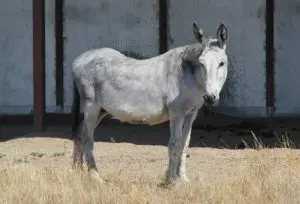

When we show our donkeys, we body clip them, but if this is done, it is imperative to blanket them if it gets too cold and provide a light sheet during the cool summer nights.
Understand that they now no longer have the PROTECTION of their unique hair coat. When traveling, donkeys will sit back in the trailer and can rub themselves raw during the ride, especially if they have been clipped. When unclipped, the hair coat will keep this kind of damage to a minimum.

If your donkey does get these kinds of sores, they can usually be healed fairly quickly with a daily application of Neosporin ointment (Photo below was taken one week later). Note that when you clip, there is also the consideration of sunburn.

If you clip your donkey for show and need to haul any distance at all, you should protect his precious rear end by using a blanket or sheet secured over the hind quarters. The best course of action is not to body clip your donkey at all if you do not show. Remember, he’s a desert animal and Mother Nature has already provided him the protection that he needs against the elements.


To learn more about Meredith Hodges and her comprehensive all-breed equine training program, visit LuckyThreeRanch.com, MEREDITH HODGES PUBLIC FIGURE Facebook page, or call 1-800-816-7566. Check out her children’s website at JasperTheMule.com. Also, find Meredith on Pinterest, Instagram, MeWe, YouTube and Twitter.
© 2017, 2018, 2021 Lucky Three Ranch, Inc. All Rights Reserved.
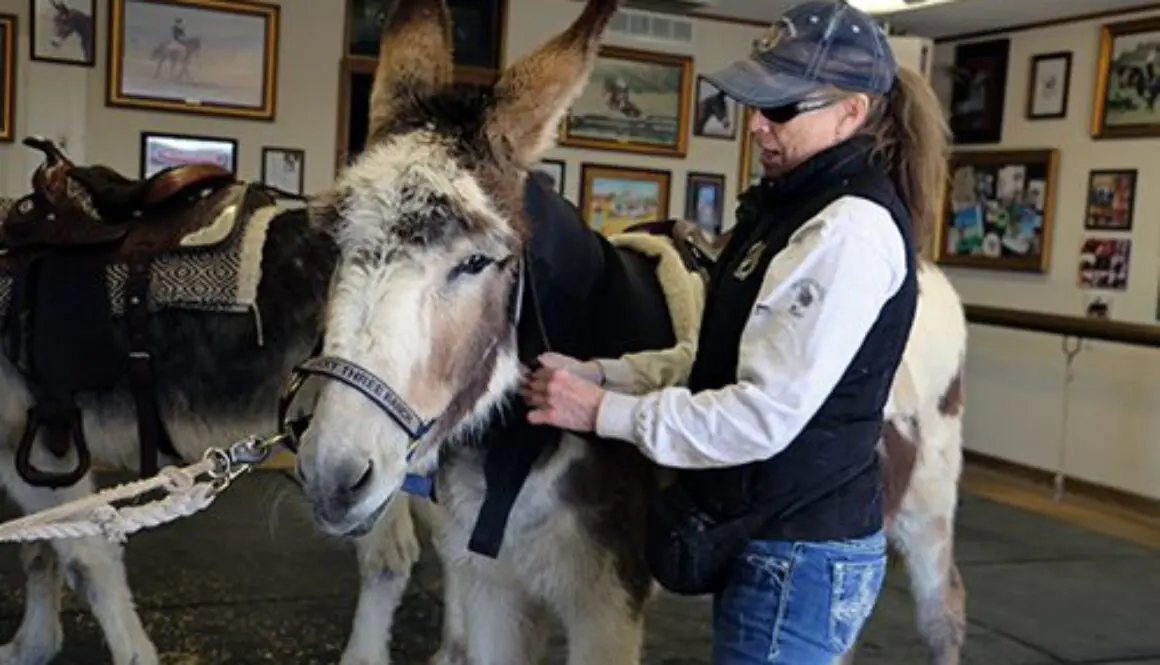
CHASITY’S CHALLENGES: After the Winter Break: 3-29-21
Due to the colder and more inclement weather here in Colorado, Chasity has been off her exercise program for about three months. It was time to get back to work! No matter how long it has been between lessons, when you have a specific routine, the equines seem to comply easily because they know what to expect, beginning with going to their regular work station to be groomed and tacked up. In order to keep upper respiratory disease at bay, eye infections and ear problems to a minimum, it is advisable to clean these areas with a damp towel regularly. Be polite and wipe the towel in the direction that the hair lays and clean the nostrils with a circular motion. This repetition will prevent them from getting head shy.
Chasity still thinks the vacuum cleaner is questionable, but she tolerates it now. Not only does it pull the dirt from the skin for healthy hair growth, it also promotes circulation better than massage and does a better job at softening her “fat roll.” I used massage in the beginning when Chasity first came here with her enlarged crest (photo below on the right).
It had become somewhat enlarged again about three weeks ago, but after two sessions with the vacuum cleaner, it has decreased substantially already.
Another valuable therapeutic grooming tool is this simple human, multi-bristled hairbrush. It is not only VERY helpful during shedding, but also works to further stimulate the hair coat and promote better circulation, as well as efficiently removing dirt from the skin. I have found it to be more helpful for healthy hair than any equine grooming tools. The long, thick hair coats of winter and spring stay soft and healthy when I use this hair brush over the entire body. I only clip bridle paths when the weather gets warmer and I leave body clipping for showing. The only other grooming tools I use are a shedding blade to remove mud and a dandy brush to finish the coat. They can have balding spots from rubbing during the shedding season and may even get sores, but I just treat those with Neosporin and they recede quickly. A healthy hair coat will insulate your equine from the heat and cold and protect them from insects better than any artificial products or practices.
Equines do like feeling clean all over and really do appreciate your efforts at keeping them this way…although, they don’t necessarily show it when the first thing they do after a good grooming is to go for a good roll in the dirt!!! Still, they do seem to realize that you care and will show their appreciation in a multitude of other ways…like being happy to leave their companions to go with YOU and stand quietly during grooming, tacking and hoof care!
Feeding is a very important consideration for healthy hooves as are regular trims when needed, usually every 8-10 weeks. For donkeys, it can even be longer between trims when they wear their hooves in good balance. Chasity had hoof issues when she first arrived, but is now sporting healthy balanced feet! Remember that Longears will be more upright and have more heel than horses and ponies…and donkeys will typically be more upright and have more heel than mules.
Fitting saddles can be tricky. Make sure the saddle makes even contact behind the withers and over the back with relief from pressure over the spine. Many saddles sit too high and cause centralized and uneven pressure across the back. Pressure points are easily identified after a workout. The back will be sweaty, but the pressure points will be dry.
Place the saddle in the center of the back, behind the shoulder blade, the girth falling 4” behind the forearm where the skin is thicker and body begins to swell. I have successfully used cruppers with the buckles set away from the tail to hold it in place. The crupper is adjusted with just enough tension so the tail will still be able to rest comfortably.
I am using the neck sweat on Chasity for lunging to promote a decrease in the crest. When bridling, I press my thumb on the bars of her mouth to get it open and protect her ears with my hands as I pull the crown piece to the poll. This promotes trust and keeps any equine from getting ear shy.
On an English saddle there is a small d-ring that I use to tie up the reins.
Then it is off to the Round Pen. I always stay in sync with their front legs when we walk and execute the gates EXACTLY the same way EVERY TIME! All movements are predictable, never abrupt. They comply due to trust.
I adjust Chasity’s postural restraint, the “Elbow Pull,” and then remind her to give to the tension to get the release with a reward of oats for flexing at the poll. Wrangler, “Mr. Curiosity” watches intently…they do learn from each other!
Chasity’s overall posture has changed dramatically as has her movement. She uses her body much more efficiently.
Chasity has strong hind quarter engagement with an uphill balance to promote enthusiasm, endurance and stamina.
A reward is always in order for a job well done. Her forward stretch has improved greatly in one short year.
The lateral stretches are also much improved. After five rotations of walk, then trot, then reverse and repeat the other direction, 3 sets with a 3 minute break in between, then stop. Done once a week is adequate to maintain conditioning.
I hold the halter crown strap in my hand and protect her ears as I remove Chasity’s bridle. Then I slip the bridle onto my left arm, bring the noseband over her nose with my left hand and fasten the halter to the strap in my right hand. This ensures that I can keep hold of her should she try to pull away. Last, I fasten the tie strap from the hitch rail.
I always unfasten the girth on the left, then tie up the girth on the right, slide the saddle back, loosen the crupper from the tail and take off the saddle on the right side. This gets the equine used to being handled from BOTH sides. I always rinse the bits and wipe any dirt from the bridles and saddles before putting them away…saves work in the long run!
I remove Chasity’s neck sweat to see how much sweat is underneath…encouraging! We are definitely making progress!
To end, we do a few more stretches in each direction. These are improving immensely, too!
Then it’s walking IN SYNC back to the barn for turnout in the larger dry lot. They enter the stall, ladies first, and then they both turn around to allow me to remove their halters and to enjoy their last reward. I keep all my donkeys off grass most of the time. I find that they stay healthier and do not run the risk of getting obese that way. They do have large dry lots for turnout on pea gravel every day and a couple of acres of dirt pen for really stretching their legs every other day. They do get some grass when we go for walks, but do not seem to miss it most of the time. They are too busy playing and resting with each other…and looking forward to our next lesson TOGETHER!
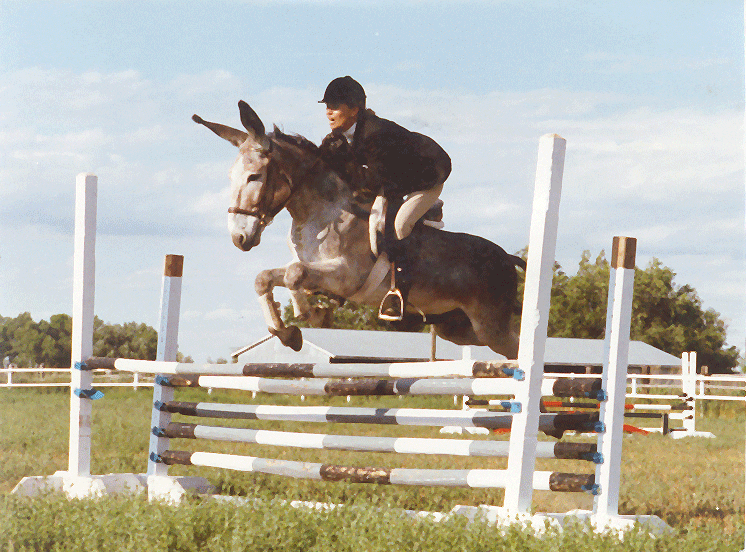
MULE CROSSING: Little Jack Horner
By Meredith Hodges
 Little Jack Horner , 13 HH Sire-Supreme of the Lucky Three Ranch in Loveland, Colorado, was the last jack born at the famed Windy Valley Ranch in Healdsburg, California owned by my mother, Joyce Doty. He was foaled June 11, 1980, by the renowned Windy Valley Adam (14.2 HH) and out of Windy Valley Maude (15 HH). His ancestry can be traced back to the original breeding stock of George Washington’s farm at Mount Vernon, Virginia.
Little Jack Horner , 13 HH Sire-Supreme of the Lucky Three Ranch in Loveland, Colorado, was the last jack born at the famed Windy Valley Ranch in Healdsburg, California owned by my mother, Joyce Doty. He was foaled June 11, 1980, by the renowned Windy Valley Adam (14.2 HH) and out of Windy Valley Maude (15 HH). His ancestry can be traced back to the original breeding stock of George Washington’s farm at Mount Vernon, Virginia.
 In 1984 and 1985, Little Jack Horner captured second place in the Bishop Mule Days World Show Halter class for Standard Jacks. His impeccable show record consists of first and second place standings at Halter in his home state of Colorado, and in 1986, he placed first at Halter in the American Donkey and Mule Society Registered Jacks class at the A.D.M.S. Nationals in Dallas, Texas.
In 1984 and 1985, Little Jack Horner captured second place in the Bishop Mule Days World Show Halter class for Standard Jacks. His impeccable show record consists of first and second place standings at Halter in his home state of Colorado, and in 1986, he placed first at Halter in the American Donkey and Mule Society Registered Jacks class at the A.D.M.S. Nationals in Dallas, Texas.
In 1984, he made his debut in performance at the Colorado Classic Horse Show, placing first in Donkey Driving and Donkey Pleasure.  His willing disposition held him in good stead, placing him first in Donkey Pleasure and Donkey Driving at Bishop Mule Days in 1989. Little Jack Horner (by his own enthusiastic request via running the fence) was trained in Dressage and Jumping along with his numerous offspring mules. He reached Second Level Dressage over three years and jumped four feet in exhibition at Bishop Mule Days in 1991 where he received a Specialty Award for his efforts. At Bishop Mule Days in 1993, he placed first in Donkey Pleasure, Donkey Pole Bending and Donkey Keyhole.
His willing disposition held him in good stead, placing him first in Donkey Pleasure and Donkey Driving at Bishop Mule Days in 1989. Little Jack Horner (by his own enthusiastic request via running the fence) was trained in Dressage and Jumping along with his numerous offspring mules. He reached Second Level Dressage over three years and jumped four feet in exhibition at Bishop Mule Days in 1991 where he received a Specialty Award for his efforts. At Bishop Mule Days in 1993, he placed first in Donkey Pleasure, Donkey Pole Bending and Donkey Keyhole.
 Although Dressage proved difficult (as it would be for any donkey), it helped to set the stage for his incredible athletic ability to jump. He soared over fences to 4’6” without a rider and worked up to 4’ with the rider on board. In keeping with traditional Dressage, Little Jack Horner worked on a Pas de Deux in Jumping with another Colorado Standard Jack, Blue Zebulon owned by Fran & Larry Howe of the Bitterroot Mule Company. Those who know the difficulty of working jacks together at all will appreciate their unique dispositions and good manners! Little Jack Horner proved himself to be not only a well-conformed breeding jack, but also a true athlete! He was inducted into the Bishop Mule Days Hall of Fame in May of 2014.
Although Dressage proved difficult (as it would be for any donkey), it helped to set the stage for his incredible athletic ability to jump. He soared over fences to 4’6” without a rider and worked up to 4’ with the rider on board. In keeping with traditional Dressage, Little Jack Horner worked on a Pas de Deux in Jumping with another Colorado Standard Jack, Blue Zebulon owned by Fran & Larry Howe of the Bitterroot Mule Company. Those who know the difficulty of working jacks together at all will appreciate their unique dispositions and good manners! Little Jack Horner proved himself to be not only a well-conformed breeding jack, but also a true athlete! He was inducted into the Bishop Mule Days Hall of Fame in May of 2014.
As a breeding jack, Little Jack Horner produced some of the finest saddle mules in the world. Consistently, his genetic makeup was responsible for extremely attractive heads, refined straight legs and good angles in the hip and shoulder of his offspring mules and donkeys. In addition,  these mules and donkeys reflected a smooth flowing topline, with depth of girth and a good length of neck for overall balance and beauty. Little Jack Horner’s mule and donkey offspring generally grew to the mare’s (or jennet’s) height or 2 inches taller despite L.J.’s own smaller size.
these mules and donkeys reflected a smooth flowing topline, with depth of girth and a good length of neck for overall balance and beauty. Little Jack Horner’s mule and donkey offspring generally grew to the mare’s (or jennet’s) height or 2 inches taller despite L.J.’s own smaller size.
 Lucky Three Firestorm never lost a Halter class and was an all-around English Champion Arabian mule.
Lucky Three Firestorm never lost a Halter class and was an all-around English Champion Arabian mule.
It didn’t seem to matter with what breed of mare or jennet he was bred. His superior qualities shone through in his offspring, giving the mules an appearance more like really nice looking horses (and donkeys!), only with longer ears!
 Not only did Little Jack Horner seem to improve on the characteristics of the mares with which he was bred, but also with the jennets as well. At Lucky Three Ranch, we endeavored to produce a Mammoth Donkey with these same refined characteristics as Mammoth’s typically have a lot of thick bone in the joints and in their faces which I wished to refine. Little Jack Horner sired two jennets, Lucky Three Pantera and Lucky Three Serendipity , who indeed retained his refinement within a much larger frame. Pantera , as a two-year-old gray jennet, stood at 14.3 hands and Serendipity as a yearling, stood 13 hands, the very same height as her sire. Pantera matured to 15.2 hands and Serendipity matured to 14 hands. When we bred the daughters back to Blue Zebulon from the Bitterroot Mule Company, the offspring jacks did indeed retain Little Jack Horner’s refinement with no unsightly boniness in the heads and joints. His offspring were most often taller than both the mare and sire . Little Jack Horner proved time and time again that the jack is indeed responsible for the shape and thickness of bone, and not necessarily for the overall height of the offspring.
Not only did Little Jack Horner seem to improve on the characteristics of the mares with which he was bred, but also with the jennets as well. At Lucky Three Ranch, we endeavored to produce a Mammoth Donkey with these same refined characteristics as Mammoth’s typically have a lot of thick bone in the joints and in their faces which I wished to refine. Little Jack Horner sired two jennets, Lucky Three Pantera and Lucky Three Serendipity , who indeed retained his refinement within a much larger frame. Pantera , as a two-year-old gray jennet, stood at 14.3 hands and Serendipity as a yearling, stood 13 hands, the very same height as her sire. Pantera matured to 15.2 hands and Serendipity matured to 14 hands. When we bred the daughters back to Blue Zebulon from the Bitterroot Mule Company, the offspring jacks did indeed retain Little Jack Horner’s refinement with no unsightly boniness in the heads and joints. His offspring were most often taller than both the mare and sire . Little Jack Horner proved time and time again that the jack is indeed responsible for the shape and thickness of bone, and not necessarily for the overall height of the offspring.
 Be it donkey or mule, Little Jack Horner’s offspring always placed at the top of the Halter classes in the early shows and in the top five when they began competing in performance classes.
Be it donkey or mule, Little Jack Horner’s offspring always placed at the top of the Halter classes in the early shows and in the top five when they began competing in performance classes.
In January of 1989 at the National Western Stock Show in Denver, Colorado, Little Jack Horner and nine of his offspring, both mules and donkeys, made a clean sweep at the show and won everything in every class in which they were entered.
 Appaloosa mule, Lucky Three Ciji never lost a Halter class, placed in the top five in the Western Performance divisions at multiple shows across the country and was a Side Saddle Champion, and Reserve Champion the following year, against horses in the International Side Saddle Organization.
Appaloosa mule, Lucky Three Ciji never lost a Halter class, placed in the top five in the Western Performance divisions at multiple shows across the country and was a Side Saddle Champion, and Reserve Champion the following year, against horses in the International Side Saddle Organization.
Appaloosa mule, Lucky Three Eclipse won the Bishop Mule Days Champion Warm-Up Hunter class in 2000. At the Lucky Three Ranch in 2017, we still have multiple Little Jack Horner offspring from various horse breeds  (Appaloosa, American Quarter Horse, Arabian, Thoroughbred and Paint) including one Warm Blood mule bred from a Trakehner mare that I acquired for the expressed purpose of doing Dressage due their their extraordinary movement. Little Jack Horner’s offspring here at the ranch are all healthy and are still being used for ranch work, even though most of them are well over twenty-five years of age, and some are thirty years and over.
(Appaloosa, American Quarter Horse, Arabian, Thoroughbred and Paint) including one Warm Blood mule bred from a Trakehner mare that I acquired for the expressed purpose of doing Dressage due their their extraordinary movement. Little Jack Horner’s offspring here at the ranch are all healthy and are still being used for ranch work, even though most of them are well over twenty-five years of age, and some are thirty years and over.
When I said good night to Little Jack Horner one chilly fall evening on October 5, 2014, I noticed that he was unusually calm and serene. He stood motionless with a colorful rainbow arched over his pen showering him in a surrealistic light as the sun began to set behind the Rocky Mountains that he loved . Little Jack Horner passed  away quietly that night at the age of 34 years, but his legacy remains.
away quietly that night at the age of 34 years, but his legacy remains.
He set the bar exceptionally high for Longears everywhere and because he did, the interest in mules and donkeys has increased exponentially over the past 40 years. The old myths about donkeys and mules being stubborn and hard to work with are being laid to rest because of his efforts. What he taught me will go down in history to become my legacy as well. His story and that of his offspring needed to be told, so I documented everything I learned from them to pass on to future generations. I was very blessed to be the steward of such an extraordinary individual and to be able to go forward as the keeper of his children. He was a very special donkey for a very special time!
Little Jack Horner has left quite a legacy! It does my heart good to see how the quality of mule and donkeys has improved exponentially over the years with foundation sires such as Little Jack Horner and…
Black Bart , bred by Sybil Sewell from the famed Windy Ridge Farm in Canada and owned by Don and Irma Mode of Oregon. Mules, once bred from culled mares, are now being bred from the best! Through more careful donkey selection, they have also improved substantially in conformation and have thereby produced incredible breeding jacks and jennets for the future!
To learn more about Meredith Hodges and her comprehensive all-breed equine training program, visit LuckyThreeRanch.com, MEREDITH HODGES PUBLIC FIGURE Facebook page, or call 1-800-816-7566. Check out her children’s website at JasperTheMule.com. Also, find Meredith on Pinterest, Instagram, MeWe, YouTube and Twitter.
Covered in TRAINING MULES & DONKEY: A LOGICAL APPROACH TO TRAINING, TRAINING WITHOUT RESISTANCE andEQUUS REVISITED at www.luckythreeranchstore.com.
© 1988, 2016, 2024 Lucky Three Ranch, Inc. All Rights Reserved

CHASITY’S CHALLENGES: Maintaining a Happy Donkey: 3-2-21
When Chasity first arrived, we needed to keep her in quarantine, away from the other animals for a minimum of two weeks. Over the past 41 years, we altered our facility to an all-steel facility. Reduced maintenance costs enabled us to proceed converting from wood and wire to steel until we completed the process. This has greatly reduced the overall maintenance costs for the entire ranch, enabling us to purchase steel panels for the barn runs. It was easy to quarantine Chasity safely and still allow her company (at a distance, of course!) and an introduction to her future stable mate, Wrangler. About every five years, we do have to spray paint the panels to keep them looking new, but this is a small price to pay for a happy donkey!
Once out of quarantine, Chasity and Wrangler were stabled next to each other. All of our runs are bedded with four inches of pea gravel. This promotes good drainage and keeps things from getting muddy. This, in turn, provides a hard surface for good hoof health and will not chip their feet because of its rounded shape. Each of our donkeys is given a soccer ball for play in the smaller areas. The ground surface is also soft and comfortable enough for them to lie down without causing shoe boils or sores. They learn to come by calling them to the end of the runs and rewarding with oats.
The mini donkeys’ pens are the same way, as is the road around the sandy dressage arena where they can also be turned out in the larger dirt area when it is not in use. They really enjoy a good roll in the sand.
Donkeys are desert animals and can easily become obese when exposed to green pastures. I only take my donkeys out to pasture to play with me.
My 60’ x 180’ indoor arena is lined with steel panels. I have a 45’ Round Pen at one end with obstacles inside the side gates around the south end. The enclosed area makes for good obstacle training with minimal distractions. Round Pen work and turnout in the open area during bad weather is completely safe and NON-DESTRUCTIVE!
At first, Chasity would not come to me at the stall door, but after being chased once into the stall to be haltered, she soon gave in easily. I always halter in exactly the same way, in the same place. They love routine.
The oats reward assures that she will repeat the behavior. After only one lesson, she now comes to me every time to be haltered. For clean, dry stalls, we bore a 2’ wide x 4’ deep hole in the center, fill it with 1 ½” rock, cover it with four inches of pea gravel and put rubber mats on top. The pea gravel is held in with 2” x 6” boards bordered by angle iron.
Since we had no animals in the north stalls, we took down the panels and made a large turnout area bedded in four inches of pea gravel for Wrangler and Chasity. It was plenty large enough to romp and play…and not get muddy!
When I am out and about the barn, I reinforce Wrangler and Chasity’s will, as well as all the others, to come to me for their oats reward. We keep bulk rock, pea gravel and structural fill in bays behind the indoor arena.
When the equines are in turnout, we replenish the pea gravel as needed with the Skidsteer.
Wrangler and Chasity, our miniature donkeys Augie & Spuds, miniature mule Francis and miniature horse Mirage also have alternate access to a very large 2 ½ acre dirt pen…Large Standard donkeys one day, miniatures the next.
When it is dry, they can take turns on alternate days in the larger area to stretch their legs and buck to their hearts desire. They do not seem to miss being in the pasture with this kind of management and they really do stay very healthy. We have no incidence of colic, founder, abscesses, skin irritations, rashes or obesity.

From the SWISS BULLETIN: Project Mule Museum in Törbel
By Mariette Herzig and Josefine Jacksch
Background
The idea of creating a mule museum is already old. When the association “Interessengemeinschaft für das Maultier” (IGM) was founded 30 years ago, some members wished to realize this idea at some point. They started to collect everything about the mule and they could present small exhibitions in other museums in Switzerland.
In 2007 the working group “Museum” was formed, in 2012 the association “Mule Museum Switzerland” was founded. Its task was to push the idea of a mule museum forward.
Already in 2012, a permanent exhibition was opened within the Open-Air Museum Ballenberg, which still exists today. It shows the history of the muleteers in Switzerland and a small sust (goods handling and resting place for the muleteers).
The search for a proper location and a building for an own mule museum was started. The association found a matching barn in Turtmann, a village in the Canton of Valais. It would be the ideal location, as this is where the large mule and horse markets in the canton of Valais used to be held, and it was the starting point of the mule trails into the southern side valleys and into Italy. Unfortunately the project could not be started until now for various reasons. It has been put on hold until further notice.
When it was founded in 2017, the Swiss Mule Museum Foundation was given an old barn and stable in the Valais mountain village of Törbel by three families. The barn is already 350 years old and stands in the middle of the historic village center. It is registered in the Swiss list of villages worthy of national protection.
Törbel is a real stroke of luck. It was the village with the most mules at that time; it was famous for its muleteers, who showed good handling in dealing with the animals; the artist Helen Güdel still lives here, who wrote and illustrated the children’s book about the mule “Apollo”. She also has her small Hosennen-Museum; the people of Törbel donated many objects to the museum, which were formerly used in the work with the mules; the political community and the inhabitants are fully behind the project and help everywhere; with the association and open-air museum “Urchigs Terbil” we could agree that our museum would be integrated into its tour.
The foundation started looking for sponsors. It was not easy, but little by little money came in. Not only from Switzerland, but also from abroad: Loveland Longears Museum & Sculpture Park, Meredith Hodges.
The foundation engaged the young architect Thomas Juon and various craftsmen from Törbel and the surrounding area to renovate the barn. In October 2019 the renovation plans were drawn up and fortunately the craftsmen were able to start work despite the Corona crisis. Everyone was very motivated and did a good job.
Spring 2020
At the end of May we (Ursi, Elke, Josefine and Mariette, members of the Foundation) met for the first time with Beat Gugger in Törbel, the exhibition expert who had already helped with the exhibition at Ballenberg. He will again develop an exhibition concept.
On a short tour of the village, Beat was able to get a first impression of this mountain village high above the Visper valley. He was already impressed by the narrow road and the steep slopes just behind the crash barriers during the bus ride here. He immediately realized that up here one could only work with mules.
During a stopover in the barn, we got an idea of the progress of the renovation work and the future exhibition rooms. During the tours, the historical building (stable barn) will be shown on the one hand, and the mule and its history in the mountain region will be presented on the other.
Erich Wyss, village historian and one of the guides, accompanied us on to the baking house, where he explained how rye bread (a Valais specialty) was baked for the whole village at that time. We were all very impressed by Erich’s enormous knowledge.
In the late afternoon we had to go to the civil defense facility. The community had provided us with a room there as an intermediate depot. The numerous museum material, which had been stored in several barns until now, was collected by the volunteers Erich Wyss, Ludwig Petrig, Othmar Zuber and Thomas Juon and delivered to the intermediate depot. Elke, Ursi, Beat, Josefine and Mariette sorted the things according to origin. We were simply overwhelmed by the crowd that gathered there. Already that evening we started with the inventory. This meant that every single object had to be taken in hand, marked with an inventory number on a label, photographed and recorded in an Excel spreadsheet with details such as name, size, material, origin.
The next day, the entire Board of the Foundation met with the architect and the carpenter to inspect the construction site. The two explained the progress of the work and drew attention to new problem areas, and the next steps were discussed. In the evening, the Foundation Board discussed with the people from “Urchigs Terbil” what the future cooperation should look like in concrete terms.
The inventory could not be completed in full, so after two weeks Josefine and Mariette travelled to Törbel again for three days. In the meantime, the foundation has already received new objects from the village as gifts.
We were only allowed to use the intermediate depot for a few weeks. Therefore all material had to be transported to Turtmann, where the foundation rented an old airplane hangar as a depot. Many objects that were donated to the foundation by the IGM and private persons are already stored there.
Before the exhibition, the objects must be cleaned, greased and prepared for the return transport to Törbel. Especially the leather objects are in dire need of it, as they were exposed to dry air and dust in the barns for years. For this cleaning action we need support from volunteers and members of the IGM.
Summer 2020
An old building often turns out to be a bag of wonders, as is our barn. Instead of renewing only a small part of the brickwork as planned, the foundation had to be renewed on three sides. It also turned out that a lot of earth had been washed up in front of the entrance, so that the lower beams rotted and had to be replaced. The budget had to be adjusted several times, resulting in additional costs of several 10’000 Swiss francs. The major renovation work could now be completed. The wooden walls still had wide gaps, which we filled ourselves with a special stuffing tape.
Meanwhile Beat has created an exhibition concept. The upper floor, where the hay was once stored, will be the actual exhibition space. One part will tell the story of the mules in the Valais mountain villages, with Törbel as a representative. The other part shows the mules in use as an all-round means of transport in the surrounding valleys and the wider surroundings.
Autumn 2020
The inventory of all museum objects from Törbel and Turtmann is now complete. The data of the Excel spreadsheet have been fed into the database of the Association of Museums of Valais. Unfortunately, some errors occurred. So now all data sets have to be rechecked and then activated individually.
The opening ceremony, which was initially planned for the end of this October, has been postponed to spring 2021. The reason for this is, as is now the case everywhere, the coronavirus. But now the Foundation is giving us more time for the preparations.

WRANGLER’S DONKEY DIARY: Riding in the Open Arena: 10-6-20
A lot of people tell me they have problems when their jennets or molly mules are in heat. And, they expect the behaviors of their gelding to change drastically when they are castrated. In my experience, it really doesn’t make much difference if you have a fair and equitable management and training program. When their bodies are managed in a healthy way and they are consistently taught good manners, they will be willing and able to perform well regardless. I always approach training in a fair and equitable manner that does not throw too much at them all at once so as to avoid anxiety. Wrangler and Chasity both appreciate this (as did my jack, stallion and other females). It wasn’t until AFTER this lesson that I realized that Chasity was in heat and Wrangler was EXCITED about it! This program is a slow, logical and sequential approach that the equines truly appreciate and respond to positively no matter their mood. The results are miraculous!
Today, we were to begin with an interview about donkeys. Wrangler watched intently while Robbie wired me with the microphone. Then we went to the center of the Round Pen where I set him up and asked Wrangler to stand quietly while we did the interview, and he did what he was told. Such a good boy!
After the interview, Wrangler did his exercises of five rotations at walk, trot and even a little bit of canter. He is getting really good about stretching his spine from head to tail and his flexibility is greatly improved.
Since Wrangler had previously bolted with the lunge line in the dressage arena, I thought another lesson might be in order. I asked for the halt. Then we went to the open arena where I tied the end of the lunge line to the his bit with four inches to spare that I ran under his chin and snapped to the bit ring on the other side. This would prevent the bit from being pulled through his mouth.
I first lunged him to the right at walk and trot, halted him and changed the line to the other side. I gave a slight pull on the lunge line as his outside front leg was in suspension as a cue to keep him on the arc of the circle.
Wrangler did very well, so I stopped him and he stood quietly while I rolled up the lunge line. He followed me when I put away the line and stood still again while I prepared to mount.
Once mounted, the reward was in order followed by a rein back. He was offering more steps in each new lesson with only very slight squeeze/releases from my little fingers.
We did a very well-balanced turn on the haunches and made our way into the Hourglass Pattern. Wrangler proceeded forward with an energized working walk.
Wrangler remained erect in his body carriage as we made our way through the pattern, bending his body appropriately through his rib cage to the arcs of the turns and moving in good posture on straight lines.
Wrangler remained soft in his response to my hands, seat and legs. Donkeys are notorious for leaning against pressure, so it was imperative that I kept myself relaxed and “giving” to his movement.
Wrangler’s internal pendulum kept him moving through the Hourglass Pattern in a very nice balance, first through the pattern one way, across the diagonal and again in the opposite direction. My inside leg at the girth on the turns helped him to stay erect while my outside leg was well back to support the bend and encourage impulsion.
Wrangler obediently executed a square halt followed by a nice rein back with the lightest of cues from my fingertips. When you are patient and spend the time to train your equine this way, it makes a world of difference in their gaits and produces an incredibly smooth ride!
Wrangler stood quietly during the dismount and went through the gate perfectly! It was truly a resistance-free lesson! That is what you will get when you spend time on accuracy and wait for speed to come later.
Wrangler and Chasity both stood stock still while I got Chasity untied, then we all walked happily in sync together back to the Tack Barn! Leading them together is never a problem! The boundaries to good behavior have been established from the very beginning. They both know clearly what is expected!

WRANGLER’S DONKEY DIARY: Riding the Hourglass Pattern: 9-29-20
There are differences in jacks, geldings and jennets, but I have found them all to have their individual redeeming qualities. Wrangler is carefully surveying the environment while Chasity walks obediently at my shoulder. Wrangler is much more playful while Chasity is sedate. My jack, Little Jack Horner, was always an energetic, enthusiastic, fully-charged male with extraordinary ability! What they ALL have in common is their exceptional intelligence, energy conservation and strong sense of self-preservation. What has produced the most success in the management and training of all my equines has been a logical, sequential and equitable approach, executed with a polite attitude, good manners, kindness, consideration, respect and a fair reward system. If I want the best from them, I have to set a good example myself. Chasity and Wrangler politely go through the gate into the area where each will not be interrupted and will patiently wait their turn.
Wrangler is now light in the bridle in the Round Pen and ready to begin work in the Hourglass Pattern in the open arena. Since I have to use both the Round Pen and the open arena, I tie Chasity in the obstacle area so she will not need to be moved until it is her turn. Then Wrangler and I proceed to the Round Pen for his warm-up exercises where he will lunge five rotations in each direction at walk, trot and canter in both directions with a reverse in between. Too much shuffling around can cause anxiety. I prefer that they both remain calm and obedient, so I set them up for success.
Wrangler politely accepts my adjustment on his bridle, “Elbow Pull,” saddle placement and girth, then proceeds forward at the walk in good equine posture. His “Elbow Pull” remains loose and is only there as a reminder in the Round Pen and as a support should he need it when I add my extra weight under saddle in the open arena.
Wrangler trots obediently upon the verbal command and after five rotations transitions to canter. He is now up to three rotations at canter in each direction. I will add one more rotation in each direction with each new lesson.
I slow him to a walk, do a well balanced reverse and he then proceeds once more at the walk for five rotations.
Wrangler picks up the trot promptly upon request. After five rotations, he canters for three more rotations. I will add one more next time. His overall balance at canter is slowly improving with each new lesson!
Improvement comes rapidly when you don’t try to get too much too quickly. Wrangler is eager and ready to be ridden!
I ask Wrangler to come through the gate and he turns back to me to receive his reward. Then I mount and give him another reward from his back. I truly appreciated his well-practiced good manners!
Once mounted, I ask for the familiar rein back and we then proceed forward into the Hourglass Pattern. Wrangler stays light in the bridle and takes gentle directional nudges from my calves in sync with the direct rein cues.
Wrangler remains upright in his balance, bends through his rib cage through the arcs in the pattern, and halts squarely and promptly upon command.
Preparing your equine with PLENTY of groundwork, the right kinds of exercise and use of the “Elbow Pull” to help build his core strength adequately in good posture to support a rider BEFORE you get on makes all the difference in the world! You are building a new HABITUAL way of moving.
Wrangler is strong in his balance, light in the bridle and promptly responsive to the cues from my seat, legs and hands. He halts squarely and reins back easily when asked.
When their balance is not constantly interrupted, they only need a weekly workout and can practice their posture efficiently in turnout each day on their own! If you WANT to work more, you can, but always be ready to leave one day of rest between 30-40 minute workout days. I always want my equines to ENJOY being with me and not get sour!

CHASITY’S CHALLENGES: Riding the Hourglass Pattern: 9-29-20
After extensive work in the Round Pen getting Chasity and Wrangler light in the bridle, we are finally ready to graduate to the Hourglass Pattern in the open arena. They enjoy working together, so I just take them both together and tie one outside the working area while I work with the other. We only do these lessons weekly, but they seem to practice good posture on their own during turnout in between lessons. Their play and rest patterns are changing and their posture is improving dramatically. They can now support my weight efficiently in the saddle, so it is now time to hone their skills in a more open setting where we can work more freely. They could trot while sustaining their good postural balance in the Round Pen without my added weight, but that is a pretty restricted place to introduce the trot with my weight in the saddle. So I will tie up Wrangler with his “Elbow Pull” while I work with Chasity.
As always, she leads easily, politely negotiates the gate and stands quietly while I adjust her “Elbow Pull” and adjust her equipment. I will tighten the girth a bit more for lunging to hold the saddle in place. I always tighten the girth a little at a time and not all at once for her comfort. She appreciates my consideration.
In preparation for riding, I will lunge Chasity first. When I ride her, I want her sufficiently warmed up and responsive to perfecting our communication skills. The five rotations at walk, then trot in each direction is sufficient exercise with some speed as she is now well-balanced while performing these tasks. The faster gaits under saddle will come later.
Chasity executes a very nice reverse and immediately slows to the walk, maintaining her good posture. When they are in a good equine posture, the entire length of the spine is stretched, causing space and elasticity between the vertebrae.
If the equine is perpetually allowed to carry their head too high, the vertebrae can become stuck and calcified too close together and over time can cause a condition called “Kissing Spine” that keeps the spine rigid and inflexible.
After a sufficient warm up with the addition of a bit of canter while tracking to the right, Chasity is ready to be ridden in the Hourglass Pattern. She obediently comes out the gate and turns to me for her reward.
I politely mount, settle onto her back softly and offer her reward as I did in the Tack Barn and then in the Round Pen. She stands absolutely still.
Then we do a rein back before moving forward into the Hourglass Pattern. Contrary to popular belief, this “pattern training” will allow Chasity to concentrate on the details of tracking forward, bending and staying light in the bridle.
The arcs and turns in the Hourglass Pattern allow Chasity’s internal pendulum to swing from side to side and come to rest at dead center when she finally halts. She maintains straight lines and bends to the arcs through her rib cage.
When an equine is perpetually schooled on the rail or in too many circles in one direction and then another, this radical movement does not allow the internal pendulum to become centered and balanced.
There is an optical illusion that takes place when riding the rail that “pushes” the balance continuously to one side. Straight lines become difficult and bending will be stiff at best.
This swaying in the Hourglass Pattern from one arc to another keeps the internal pendulum moving freely from side to side while the equine moves freely forward. It produces fluid motion and relaxation in the equine.
All of this keeps the animal responsive, light in the bridle and facilitates good postural movement that results in squared halts and straight rein backs. They enjoy their work because it FEELS good!
Chasity stands still while I fish in my pocket for her final reward for a job well done! Her balance is solid!
We then go back to the Round Pen area to retrieve Wrangler from his “spectator seat!” Wrangler and Chasity have been taught exactly and consistently the same way, so they are quite maneuverable and willing to do as I ask. I have not experienced a “balky” donkey or mule in years!
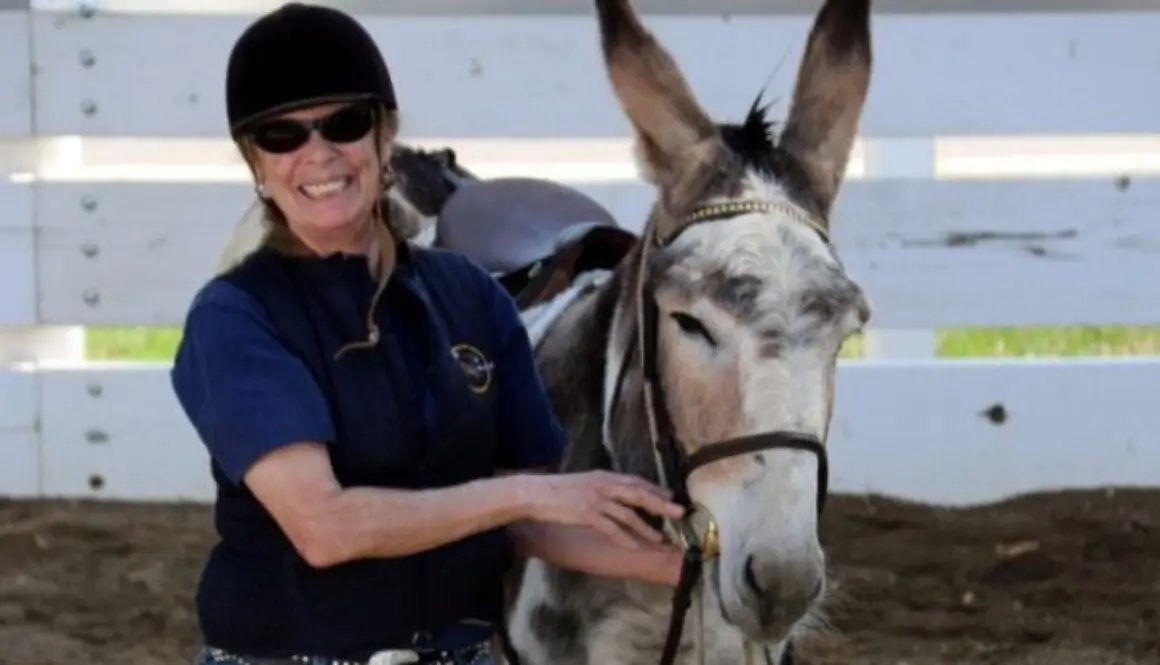
CHASITY’S CHALLENGES: Fine Tuning Chasity’s Response: 9-22-20
In the many years of the management and training of equines, I have learned how much the details really count! I learned about how much easier things can be when you are open minded and allow your education to grow. For instance, I learned how to train without the bit and bridle, but then learned that in doing so, I was not able to control postural development in the equine’s body. Thus, I invented my “Elbow Pull” as a response to Richard Shrake’s “Rhythm Collector.” I also found out that my “Elbow Pull” could be used in conjunction with the mild Eggbutt snaffle bit in a multitude of different ways, even for tying an animal. It is practically weightless and easily slips through the bit rings for optimum adjustment while the equine is in motion. It does need to be adjusted differently with horses, but the results are amazing as you can see with Chasity’s physical improvement.


Chasity’s huge cresty neck is practically gone now and the neck sweat has not been needed since she graduated to the Round Pen. This was because I have been repetitious in the way we execute ALL movements, even going through gates, in good equine posture! When we do this, Chasity uses ALL the muscles in her body to do these moves, and in this case, stretches across her spine to pull the Supraspinous ligament back into alignment while reducing the fatty tissues with efficient metabolic circulation. She is a lot more comfortable in her body, so standing quietly is no longer an issue.


Chasity has learned her verbal commands and responds promptly and quietly. Since donkeys do not freely exhibit as much energy as horses and mules, I only ask for five rotations at walk followed by five rotations at trot. As she is better able to keep her balance in good posture, the “Elbow Pull” remains loose, with very little tension throughout her whole workout.


Only now, instead of halting, resting and then changing direction, I do the whole exercise with a reverse in the middle for the change of direction. Her core is becoming more stable in her self-carriage. The muscles across her spine are becoming stronger and better able to support the weight of a rider.


She is relaxed, moves freely forward and most of the time halts four-square. Since she was a bit sticky with the reverse under saddle during her last lesson, I will add a step and ask for the reverse from the ground first.


Chasity understands what I mean and backs easily upon the command to “Back.” I then walk to the other end of the Round Pen and ask her to come to me with a verbal “Come,” also using hand signals. There is nothing more important than communicating clearly.


I politely ask Chasity to “Whoa,” with my hand put up like a “Stop” sign, and then mount her while she stands still. I pay special attention to lowering my seat slowly onto her back.


As I did in the Tack Barn when I first mounted her, I lean over to both sides and offer her reward of crimped oats for standing still, sit quietly in the saddle while she chews and then asked her to first rein back. I keep my contact VERY light, with an alternating squeeze/release from my little fingers on the reins, and a backward motion from my legs and seat.


When ready to go forward, I nudge her with my legs and then WAIT for her response. If she does not move right away, I nudge her again after waiting a few seconds. It will often take donkeys a little longer to THINK about what you are asking. It is far more productive to give them that time. Chasity walks off obediently and keeps her mind on her work as she passes Wrangler, waiting patiently for HIS turn!


I now add small circles randomly as we walk around the Round Pen. We pay special attention to staying erect and bending through the rib cage. I keep things slow, controlled and accurate.


We do “S” turns through the middle of the Round Pen to change direction. Speed can come later as the strength in good posture is developed and the connection to her bit remains light at all times.

I have discovered with this approach, there is hardly ever (if ever) any resistance or bad behaviors. Lessons go smoothly and safely for both of you. This is something I greatly appreciate with age!


Chasity maintains her good balance and cooperative attitude as we ride for about 15 minutes, practicing the circles, halts, “S” turns and reverses. Chasity comes to a “square” halt. I wait quietly for a few seconds.


Then I ask Chasity for a rein back and she complies easily…still light in the bridle. I dismount and tell her how pleased I am with her. I playfully massage her upper gums to illicit a smile! They like having their gums rubbed!


It was a very satisfying workout for us both! Chasity follows me as we exit the Round Pen and get ready for Wrangler’s turn! Allowing one animal to wait while another is worked, makes it easier to do the training. They seem to get support from their “Friends.” Occasionally working them alone as they gain confidence lets them know that being with you can always be fun and that you will always return them to their friends. This approach allows you to deepen the relationship between you, so you become as good a friend to them as their equine companions. This greatly eliminates the incidence of your equine becoming herdbound.



WRANGLER’S DONKEY DIARY: Wrangler’s First Ride: 9-15-20
Wrangler has now completed his preparation for efficiently carrying a rider while staying in good equine posture with adequate core strength. Doing these kinds of logical and sequential exercises in a consistent manner makes all the difference in an equine’s physical development and mental attitude. Groundwork needn’t be boring for either you or your donkey. Doing these exercises the same way, every time, creates an unbreakable bond and deep understanding of what is expected between you. Before mounting your donkey in the Round Pen, there is one more interim step that needs to be done to keep your donkey standing still and his attention on you as you mount him. In the grooming area, I will mount the donkey and have him take oats from both sides of his body as we stand there. Then we will go to the Round Pen, do the preparatory lunging he has done before and mount in the same fashion. This will set up your donkey for success!


By now, your donkey should know his verbal commands and will not be compelled to just take off at the trot. He will walk leisurely along the perimeter of the Round Pen until you ask for the trot. He will remain in good posture and keep the “Elbow Pull” loose throughout his workout. He will have a rounded topline and overall balance that can easily support the added weight of a rider. Wrangler is doing beautifully!
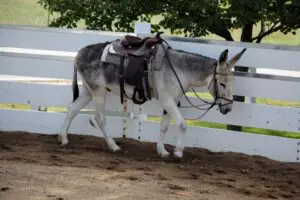

After five rotations at walk and five rotations at trot, I ask Wrangler to slow to a walk. I then turn away from him in the opposite direction he is traveling and step in front of him to encourage him to reverse.
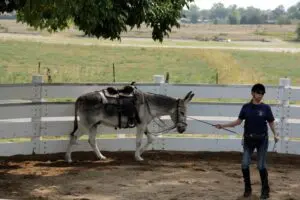

Then I send him to the rail for five more rotations at walk and then five at the trot. Wrangler is relaxed and moving freely forward. He is obviously strong in his balance and ready to be ridden.
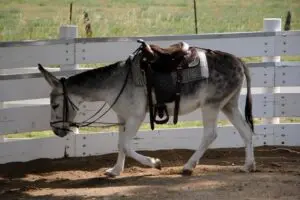

I ask Wrangler to “Whoa,” reward him for his stellar performance and ask him to stand four-square with equal weight over all four feet in preparation for mounting. I do not want to throw him off balance as I pull my weight into the saddle. Most equines will move if they feel a loss of balance. I politely mount and settle my seat easily in the saddle. I do not rudely plop myself down on his back.


As soon as I was mounted, I balanced myself in the saddle and offered rewards for standing still from both sides. My first move while mounted was the rein back. This would get his attention off bolting and put his mind on a task he can easily do. He is then rewarded again and happy with his accomplishment.


We walked for two rotations tracking to the left and then did an “S” turn through the middle of the Round Pen to change directions. I paid special attention while bending his body through the “S” turn to keep Wrangler’s body erect. I encouraged him to bend through his rib cage to make the turn smooth, forward and fluid.


We did two more rotations at the walk, then I asked for a balanced and correctly executed reverse. It is important to pay attention to the minute details while working slowly. This will promote accuracy later when you speed things up.


I walked Wrangler into a smooth and balanced halt. I made sure my own body was over the center of balance and that my hands and legs were even on both sides. I waited quietly for a few second to allow him to settle.


Then I asked Wrangler for a rein back with a pull/release action on both reins, but added a little more alternate pressure from one side to the other in sync with the front legs that were coming backwards. Wrangler did very well for his first riding session, so I thought it best to quit while we were ahead. It is easier for your donkey to learn when you keep lessons short and productive. Drilling for hours never really works…they just get tired and can’t really listen or perform well.


Although Chasity waits calmly while she is tied and Wrangler is working, he has to play with the artificial flowers in the planter when it is his turn to be tied. Next time, I will remove the temptation of the flowers! After Chasity finished her workout, we all made our way back to the work station. It was another successful and enjoyable training session for all of us!



CHASITY’S CHALLENGES: Chasity’s First Ride: 9-15-20
Chasity has come a long way since the end of March. She has worked hard and is now enjoying true strength in a balanced and correct equine posture. Her health has greatly improved as has her mental attitude. She is happy to be working with her companion Wrangler and they both enjoy being able to share their lessons. Sometimes they are walked together to the Round Pen and sometimes they are taken separately. This promotes independence while preserving their friendships with each other. I do not believe in deliberately separating my equines from their equine friends as that will only create anxiety. I want them to know that I am also a friend that they would like to spend time with or without their other companions. Sometimes they are worked alone and sometimes they are worked together. Tying one outside the Round Pen while working the other teaches them to stand quietly while tied with purposeful patience. I leave nothing to chance, so I break everything down into doable steps to promote success. Chasity is mounted in the work station first and rewarded with crimped oats from her back. This routine will keep her attention when we finally go to the Round Pen as she is mounted.
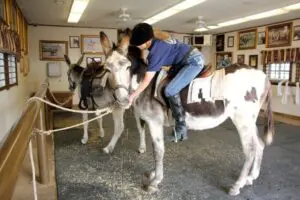

Chasity executes the gate perfectly, stands quietly to have her “Elbow Pull” adjusted and is then sent on the rail to lunge in preparation for mounting. She is now keeping her “Elbow Pull” loose at all times. Her balance and good posture is exceptional now considering her imperfect conformational restrictions.


I slow Chasity to the walk before asking her to execute a nice balanced reverse and she complies easily. It is important in the beginning to keep things slow and accurate. Speed can come later with much better results.


Chasity will now walk on command and will not change her gait until she is asked. She fully understands the verbal commands. She has smooth, upward and downward transitions as she changes gaits. She promises to be a smooth ride!


I ask Chasity for a halt and offer her a reward for a job well done! She is patient and stands quietly as I mount.


As I did in the work station, I offer her a reward from both sides. When she has finished chewing her oats, I ask her for the rein back. I use an even squeeze/release on the reins with a bit more pressure on one side and then the other as each front leg comes back. Even one step is sufficient for now. Chasity will give more with each new lesson.


Chasity walks calmly forward and I sit quietly to allow her to balance my weight. She keeps her body erect and bends through her rib cage as she executes an “S” turn through the middle to change direction. It is important to execute these moves with the lightest pull from my little fingers on the reins to encourage Chasity to become ultra-light in the bridle.


Donkeys tend to “lean” on the bit, so doing this kind of work in the Round Pen is really important if you want your donkey to be light in the bridle and respond to the lightest pressure from your seat, fingers and legs.


Be prepared to spend a lot of time on this. It will enhance all your donkey’s responses to your cues. Chasity executes a nice reverse and maintains her ideal balance at the walk afterwards. This is not easy for her to do with her hips being higher than her shoulders, but I am very pleased with her progress. She will only get better!


Chasity does a perfect halt, but is a bit reluctant to rein back. This move is difficult for her, so I will just take my time and accept what she has to offer. I know she is always honest in her attempts. One step is good, so I call it quits and reward her efforts.


Wrangler is outside the Round Pen waiting patiently for his “Lady Love” to complete her lesson. Then we all head back to the work station after our enjoyable time together! More lessons will promote more learning and more refined performance! We all look forward to our time together!



CHASITY’S CHALLENGES: Combined Groundwork: 9-1-20
Chasity is in such good condition these days that I felt I could skip a week before engaging in her formal lessons again. She does get manual abdominal flexion exercises daily when she is fed. The beauty of postural core strength exercises is that they stay strong after the initial introductory work. It has been five months of this kind of exercise for Chasity, so if her workouts are only every other week, they are enough to sustain her strong core strength in good equine posture. The muscles, ligaments and tendons are now symmetrically strong around her skeletal frame. I decided to start in the Round Pen to allow her to move out before engaging in the more intense lunging and ground driving in the open arena again. Her posture and movement were impeccable!
The “Elbow Pull” is now staying loose most of the time. This means she is strong and balanced in good postural self-carriage. Her movement is confident and fluid. She executes the turns on the haunches perfectly upon command. The transformation in her whole body and strength has been exciting to witness! Her attitude has improved by leaps and bounds as her overall health improved. We are still treating the infection she has that seems to be systemic and in her glands. Our approach will be to continue a regimen of antibiotics, then when it is done, take her off of them until it appears to be trying to return. Then we will resume antibiotic treatment.
Chasity moves beautifully and stands stock still whenever we are working on her. This is a marked improvement from the “Nervous Nellie” that first arrived at the end of March this year.
After doing a bit of lunging, we are now going to review ground driving in the Round Pen before we go to the open arena for more practice. I want to get her light in the bridle now, so I begin with a rein back. Then we proceed forward at a relaxed pace.
Chasity does a very nice “S” turn through the middle for a change of direction. I try to keep my contact with her bit as light as possible, giving her cues with no more than vibrating little fingers.
Chasity is responding well to the drive lines and is getting lighter in the bridle. She halts and rein backs easily upon command to receive her reward for a job well done!
After lunging Chasity and Wrangler individually in the Round Pen, we are now headed for the dressage arena where they will each get their turn at lunging on the lunge line and ground driving. They both lead easily alone, or together, and walk in sync with me upon request. Sometimes Wrangler gets a bit distracted.
Chasity is always on alert, but does not tend to be silly about things. She remembers her lessons well and is always happy to please. I start her with the lunge line shortened and this time she does not pull at all, but stays on the circle with her intermittent squeeze/release cues from my little finger as her outside front leg comes forward and into suspension.
As she circles, I slowly let out the lunge line. I will not ask her to trot until she offers to so so. I don’t want to force speed and sacrifice precision. She is now stopping consistently in a goos balance.
After re-tying the lunge line to the bit ring on the other side, I reverse Chasity, ask her to go the other way and she complies nicely. Again, I start with a short line and let it out gradually.
At the end of several rotations, I ask her to “Whoa,” stretch down and then stand still while I roll up the lunge line and prepare to put on the drive lines. My Ranch Manager, Chad, is ready to assist with the ground driving this time after her bolting in the previous lesson when I ground drove her by myself.
I do not want Chasity to think she can run off every time we get into the open arena, so I will set her up to be successful right from the beginning with the assistant this time. She can run and play with Wrangler in turnout later. She does not seem to mind at all and is all business about her ground driving. She completed the Hourglass Pattern in one direction, crossed the diagonal and did it in the other direction and then did a very nice halt and rein back to end the lesson.
Chasity stood quietly while I removed the drive lines and rolled them up. Then we went to retrieve Wrangler from his place along the fence. After Chasity’s turn, Wrangler got his turn at lunging on the lunge line and ground driving. Then we all headed to the gate together.
When you are consistent in the way you do things with every animal, it is easy to lead, lunge and negotiate obstacles with multiple animals because they all know what to expect and there are no abrupt changes to the routine to cause adverse behaviors. Training can be fun for EVERYONE!

CHASITY’S CHALLENGES: Leading, Lunging & Ground Driving: 8-18-20
After having a week off, Chasity returned to her lessons happy, refreshed and ready to go to work. I decided to go back to the Hourglass Pattern and do more leading exercises followed by lunging on the lunge line and ground driving in the open arena. She had two weeks of lessons in the Round Pen and I was curious to see how she would do on the single line, and then the drive lines, with lots of space around her. This can often be a whole new challenge! She seemed very relaxed as she fell into the familiar leading pattern.
As we negotiated the Hourglass Pattern, she easily matched me step for step, even over the ground rails. I asked her for a downward stretch and she was completely cooperative with that as well. The exercises she has been doing for the past four months have really changed her body shape and her strength. The thick crest on her neck is greatly reduced and is no longer hard, but soft and pliable to the touch. It won’t be long before it is completely gone. She is moving symmetrically, is much more agile and is in great athletic condition!
She was in good posture and stepped over the dressage arena fence gracefully without losing her balance at all as we went to retrieve the lunge line. She then stepped over it again as we re-entered the arena to begin lunging on the lunge line.
I started her on a short line to give her clear directions about what Iwanted. I made sure to give a short squeeze/ release on the lunge line each time her outside leg came forward into suspension like I had during Round Pen lessons. This caused her outside front leg to come toward me and keep her on the arc of the circle around me without getting into a pulling match. Pulling this way would not interfere with her balance and cause her to bolt.
As she circled, with each rotation, I let out the line a little bit more. I continued with the squeeze/release cue in sync with the outside front leg coming into suspension. Then before she got bored, I asked her to “Whoa.”
I gave Chasity her oats reward and waited for her to finish chewing before I retied the lunge line so we could go in the opposite direction. I tied the lunge line to the snaffle bit on the side I pull from and then left enough excess to go under her chin and snap to the ring on the other side. This keeps the bit from sliding through her mouth.
Again, I started her on a short line and let it out as she was compliant and stayed on the circle around me, always giving the squeeze/release cues in sync with that outside front leg. The I asked for a “Whoa” and a stretch down for her reward.
Chasity waited patiently as I put on the drive lines, always sporting a relaxed and happy face! We began ground driving at a pretty good clip. She was enjoying the open space! I stayed in sync with her back legs, but I was having to take very big steps to keep up with her!
Then as sometimes happens…she bolted. I knew she wasn’t really scared. She just felt GOOD! So rather than engage in a pulling match, I just let go. She took off, first at a very fast trot, then a lope….
…and finally she went into a full-fledged gallop! She stayed strong in her new-found good equine posture throughout! She galloped to the fence and made a nice 90-degree angle turn into a trot tracking right! She was clearly enjoying herself while I just waited on the sidelines for this moment to pass.
It was clear to me that she needed to just run and have a good time for a little bit. I watched as she traveled around the perimeter of the dressage arena. I was impressed with her improved way of going. She carried her head a bit high and was not as flexed at the poll as I would have liked, but what more could I have expected considering the short time she had been worked in the “Elbow Pull.” Enhanced grace would come later!
I was impressed with her form as she jumped over the dressage arena fence! As she executed THAT move, there was more flexion over her entire top line. This was a great improvement to the sway back she had when she first got here! She evntually slowed down and began to make her way toward me.
Since she had obviously decided to go back to work, I walked toward her and gave her a reward for returning to me!
I gathered the drive lines and instead of walking behind her, I kept them short and walked beside her for more control. I did not want another runaway! She did give a half-hearted pull, but when she discovered that I had more control, she decided to comply as I concurrently led/ground drove her back into the Hourglass Pattern
I proceeded this way over the ground rails and then toward the next corner cone. As I did, I gradually made my way more toward the hind qaurters while making sure I still had her attention. She was a little strong in the bridle, but did as I asked. We did have to circle the cone to keep this control.
As she came around the cone, she got more tractable and straightened out so I could ground drive her from her hip. We were definitely making progress!
We turned around the next cone and headed back toward the ground rails in the center of the Hourglass Pattern. At the point where we would nromally halt and square up when leading, when ground driving, we halt and normally do a rein back instead. This time, however, I would be content with the halt. I made a mental note that next time, I would use an assistant at her head with a lead rope to help her to be totally successful in the ground driving before we went solo again. I would hate to perpetuate any bad habits. One occurence like this is acceptable, but to allow it to continue would be a major mistake! Longears learn EXACTLY what you teach them!









































































